Update : 30 June, 2017
![]() Hobbled, on the DL, but still punching out the reports - our Rich Necker adds to our understanding of early baseball on the prairies and the West Coast.
Hobbled, on the DL, but still punching out the reports - our Rich Necker adds to our understanding of early baseball on the prairies and the West Coast.
In this edition, Rich has game reports and rosters for the 1913 Winnipeg Senior Amateur League and another, called simply the Semi-Pro League in Manitoba.
One 1913 game report popped up for Saskatchewan ball (noting the fighting, but not much else) so we add a new page anticipating we'll add more over time.
On the 1914 Vancouver page, we add a report on a touring Japanese university team, no-hit, but managed a tie.
![]() Rich has more for our photo display as well. First there's the 1912 Kelly-Douglas Nabobs the champs of the Vancouver Wholesale Baseball League.
Rich has more for our photo display as well. First there's the 1912 Kelly-Douglas Nabobs the champs of the Vancouver Wholesale Baseball League.
 And there's the 1914 National Biscuit Company squad, including Harley "Hap" Solloway (left) (one of three Solloways on the team) the Commercial League and Vancouver City champions. From the photo we were able to update the team roster.
And there's the 1914 National Biscuit Company squad, including Harley "Hap" Solloway (left) (one of three Solloways on the team) the Commercial League and Vancouver City champions. From the photo we were able to update the team roster.
![]() On the 1955 Ontario Photo Gallery there are a few addition pics, including Bill Andrescik, John Krycia and Sam Lima of the West Toronto Senior League.
On the 1955 Ontario Photo Gallery there are a few addition pics, including Bill Andrescik, John Krycia and Sam Lima of the West Toronto Senior League.
![]() As we begin to dig into some clippings from the 1951 summer in Alberta, we've undated some rosters (Lethbridge Miners and Cubs) and stories for the Tournament page. There are a few additions to the game reports.
As we begin to dig into some clippings from the 1951 summer in Alberta, we've undated some rosters (Lethbridge Miners and Cubs) and stories for the Tournament page. There are a few additions to the game reports.
26 June, 2017
![]() Our dynamic correspondents TIO (Rich Necker, The Indefatigable One) and NED (Henry Ropertz, Never Enough Detail) keep us hopping with more on BC ball, especially details on play in the BC Interior.
Our dynamic correspondents TIO (Rich Necker, The Indefatigable One) and NED (Henry Ropertz, Never Enough Detail) keep us hopping with more on BC ball, especially details on play in the BC Interior.
They've gone through 1957 newspaper accounts to provide game reports, rosters and even some stats on the Okanagan Mainline 
 League. The loop featured such stars of Gordie Beecroft and rubber-armed Len Gatin (left) of the Kamloops Okonots and Bill Martino (right), the pitching and hitting star of the Kelowna Orioles.
League. The loop featured such stars of Gordie Beecroft and rubber-armed Len Gatin (left) of the Kamloops Okonots and Bill Martino (right), the pitching and hitting star of the Kelowna Orioles.
The 1957 coverage also includes new and updated reports on tournament ball in Kamloops, Kelowna and Quesnel -- Kelowna Dominion Day weekend tournament, Kamloops Dominion Day weekend tournament, Kamloops Labor Day weekend tournament, Quesnel Labor Day weekend tournament
![]() The Bill Martino picture is among the additions to the 1958 BC Photo Gallery.
The Bill Martino picture is among the additions to the 1958 BC Photo Gallery.
![]() TIO and NED, our dynamic duo also checked back to 1911 for a note about the Vancouver Clovers the team which went into a BC senior challenge series and were upset by a club from Kamloops. This, of course, was supposed to be the amateur championship of British Columbia. But, there was controversy and some misleading claims and Henry Ropertz has a full account.
TIO and NED, our dynamic duo also checked back to 1911 for a note about the Vancouver Clovers the team which went into a BC senior challenge series and were upset by a club from Kamloops. This, of course, was supposed to be the amateur championship of British Columbia. But, there was controversy and some misleading claims and Henry Ropertz has a full account.
From the 1919 season in Vancouver, we present Ralph Dawson of the Wallaces of the Vancouver Senior League on our Snapshot page. .
![]() Over in Manitoba, we add a few notes on organized ball in 1913,
Over in Manitoba, we add a few notes on organized ball in 1913,
![]() In Alberta, there are additional game reports on the Alberta championship of 1921. And, the Alberta Photo Gallery has rest of the members of the that championship team.
In Alberta, there are additional game reports on the Alberta championship of 1921. And, the Alberta Photo Gallery has rest of the members of the that championship team.
![]() We're pretty happy to add more coverage of Ontario baseball, including game reports from Ontario's Intercounty League, 1952, and Toronto senior baseball in 1949 and 1952 (along with the start of reports for 1947). We fell into the Toronto senior coverage in tracking players from the famous Vancouver Asahi team after their internment during the war and forced relocation.
We're pretty happy to add more coverage of Ontario baseball, including game reports from Ontario's Intercounty League, 1952, and Toronto senior baseball in 1949 and 1952 (along with the start of reports for 1947). We fell into the Toronto senior coverage in tracking players from the famous Vancouver Asahi team after their internment during the war and forced relocation.

 A few photos have turned up for the Ontario Photo Galleries of 1949, 1952 and 1956 (such as 20-year veteran Al Yarnell (left), the playing manager of the 1949 champion Oakville nine and Ken Mitsui (right) who seemed to pitch just about every game for the Japanese-Canadian entry, the Toronto Westerns in 1949.
A few photos have turned up for the Ontario Photo Galleries of 1949, 1952 and 1956 (such as 20-year veteran Al Yarnell (left), the playing manager of the 1949 champion Oakville nine and Ken Mitsui (right) who seemed to pitch just about every game for the Japanese-Canadian entry, the Toronto Westerns in 1949.
Our 1949 game reports led to a photo of the Oakville Oaks (unfortunately no IDs yet) the Toronto senior champions. Thanks here to the Oakville Public Library ! Helpful, fast and pleasant.
They are pretty sparse, but we managed to locate a few statistics for the 1952 Intercounty League.
The 1949 Ontario Snapshot page has a pretty good photo of Al Yarnell and a couple of his Oakville Oaks and there's a photo of the Mitsui brothers.
Along with the Ontario news, there's the beginning of some news on the Southern Alberta Nisei baseball in 1947.
![]() A few more game reports from the Arrow Lakes/Slocan area of the BC Interior are noted on those pages for 1949 and 1951.
A few more game reports from the Arrow Lakes/Slocan area of the BC Interior are noted on those pages for 1949 and 1951.
![]() With all the new game reports and stats, new and updated rosters follow, including 1913 (Manitoba), 1921 (Edmonton), 1947 (BC Interior), 1949 (Toronto, Hamilton Senior, Intercounty), 1952 (Toronto Senior), 1956 (Toronto)
With all the new game reports and stats, new and updated rosters follow, including 1913 (Manitoba), 1921 (Edmonton), 1947 (BC Interior), 1949 (Toronto, Hamilton Senior, Intercounty), 1952 (Toronto Senior), 1956 (Toronto)
![]() Nothing to do with baseball, but, an interesting take on Vancouver Island in the 1930s. It's in a letter to the National Post, November 5, 2005
Nothing to do with baseball, but, an interesting take on Vancouver Island in the 1930s. It's in a letter to the National Post, November 5, 2005
Why the Globetrotters love Nanaimo
Re: Pioneers Of The Hard Court, Ben Green, Nov. 3
After reading this story about the origins of the Harlem Globetrotters, I must pass on this story of the team's visit to the coal-mining town of Nanaimo on Vancouver Island in 1938.
Abe Saperstein and his team had agreed to come to Nanaimo and put on a show at the town's new arena.
It was a glorious day for Nanaimo, with a great turnout, but due to the racism that was everywhere at the time, no hotels would house the players, no restaurants would feed them and service stations wouldn't even let them use the bathrooms or the phone.
However, they did not yet know Pete Maffeo, who later became the town's mayor.
Maffeo solved the problem by taking all of them into his home where his wife put on an enormous feed of spaghetti and meatballs. But as night fell, the problem of where they should sleep surfaced. Being giant athletes, they would not fit into a standard bedroom, so Maffeo made up a seven foot bed across the floor of his attic, and side by side they all slept.
After a good night's sleep and a hearty breakfast, they were all put on the ferry for Vancouver.
Saperstein was so overcome by the fairness and hospitality of Maffeo that he swore that however famous the team became, he would never forget Nanaimo and would always play in this little town as long as he was the boss.
He kept his word, and this world-famous team came back to Nanaimo year after year after that.
Nanaimo was, and is, a sporting and music town. Just ask Nanaimo native Dianna Krall.
Arthur Knight, Nanaimo, BC
10 June, 2017
Re: Pioneers Of The Hard Court, Ben Green, Nov. 3
After reading this story about the origins of the Harlem Globetrotters, I must pass on this story of the team's visit to the coal-mining town of Nanaimo on Vancouver Island in 1938.
Abe Saperstein and his team had agreed to come to Nanaimo and put on a show at the town's new arena.
It was a glorious day for Nanaimo, with a great turnout, but due to the racism that was everywhere at the time, no hotels would house the players, no restaurants would feed them and service stations wouldn't even let them use the bathrooms or the phone.
However, they did not yet know Pete Maffeo, who later became the town's mayor.
Maffeo solved the problem by taking all of them into his home where his wife put on an enormous feed of spaghetti and meatballs. But as night fell, the problem of where they should sleep surfaced. Being giant athletes, they would not fit into a standard bedroom, so Maffeo made up a seven foot bed across the floor of his attic, and side by side they all slept.
After a good night's sleep and a hearty breakfast, they were all put on the ferry for Vancouver.
Saperstein was so overcome by the fairness and hospitality of Maffeo that he swore that however famous the team became, he would never forget Nanaimo and would always play in this little town as long as he was the boss.
He kept his word, and this world-famous team came back to Nanaimo year after year after that.
Nanaimo was, and is, a sporting and music town. Just ask Nanaimo native Dianna Krall.
Arthur Knight, Nanaimo, BC
![]() We've added more game reports and rosters for 1931 ball on Vancouver Island, specifically the Comox Valley loop. Tragedy struck during a Dominion Day contest when outfield Fred Stephens died after making a catch.
We've added more game reports and rosters for 1931 ball on Vancouver Island, specifically the Comox Valley loop. Tragedy struck during a Dominion Day contest when outfield Fred Stephens died after making a catch.
![]() More lost and now found photos transferred from game report sections to BC Photo Galleries, 1951 (Joey Jankola), 1952 (Mike Johnson, Jim Lowe, Johnny Sofiak), 1953 (Pete Eades, Walt Hallam, Ed Henry & Ed Sparrow) and 1955 (Jack Wheelhouse, Rod MacKay).
More lost and now found photos transferred from game report sections to BC Photo Galleries, 1951 (Joey Jankola), 1952 (Mike Johnson, Jim Lowe, Johnny Sofiak), 1953 (Pete Eades, Walt Hallam, Ed Henry & Ed Sparrow) and 1955 (Jack Wheelhouse, Rod MacKay).
![]() Two photo adds to the 1939 BC Snapshots page - Nag Nishihara and another with Roy Yamamura and an unidentified Collingwood players.
Two photo adds to the 1939 BC Snapshots page - Nag Nishihara and another with Roy Yamamura and an unidentified Collingwood players.
![]() Thanks to Mark Syme for helping to sort out all the "Syme" notations in BC ball reports. His uncle Bill Syme was among them. Not often we feature a high school club, but Mark's mom dug out a photo of the 1946 BC high school champion, Ladysmith Canteen Club.
Thanks to Mark Syme for helping to sort out all the "Syme" notations in BC ball reports. His uncle Bill Syme was among them. Not often we feature a high school club, but Mark's mom dug out a photo of the 1946 BC high school champion, Ladysmith Canteen Club.
08 June, 2017
![]() Our 1957 coverage gets even better as Rich Necker digs out game reports for the Greater Winnipeg Senior League, which, in spite of the
Our 1957 coverage gets even better as Rich Necker digs out game reports for the Greater Winnipeg Senior League, which, in spite of the  pro ball Winnipeg Goldeyes, performed admirably on the amateur diamonds of the Manitoba capital. Updated rosters too. Lots of familiar names - Ed Mazur (left), Freddie Dunsmore, Tony "Phil" Rizzuto, Ab Bruce.
pro ball Winnipeg Goldeyes, performed admirably on the amateur diamonds of the Manitoba capital. Updated rosters too. Lots of familiar names - Ed Mazur (left), Freddie Dunsmore, Tony "Phil" Rizzuto, Ab Bruce.
![]() There's still a game or two for which we cannot find details, but the 1957 season of the Foothills-Wheatbelt League of Southern Alberta is pretty well in the books. Rich and I have dug out a few more game reports to fill in the missing pieces. We've added to the Snapshot page and updated a couple of pics on the Photo Gallery. And, of course, we've made appropriate additions/changes to the roster page.
There's still a game or two for which we cannot find details, but the 1957 season of the Foothills-Wheatbelt League of Southern Alberta is pretty well in the books. Rich and I have dug out a few more game reports to fill in the missing pieces. We've added to the Snapshot page and updated a couple of pics on the Photo Gallery. And, of course, we've made appropriate additions/changes to the roster page.
One of the new photos (Dave Gambee) reminds us just what an interesting group this turned out to be. Gambee, of course, became 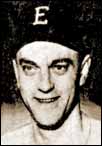 a star in basketball, playing alongside Wilt Chamberlain. Don Kirk (right), the outstanding lefty hurler, went into medicine, After a brief tour in pro ball, Ken Heffel took some diverse paths, first into ranching, then into the art world. His Heffel Gallery continues today.
a star in basketball, playing alongside Wilt Chamberlain. Don Kirk (right), the outstanding lefty hurler, went into medicine, After a brief tour in pro ball, Ken Heffel took some diverse paths, first into ranching, then into the art world. His Heffel Gallery continues today.
You know of Pat Gillick and his Hall of Fame career. There's John Adams, who received his PhD in Organizational Psychology from City University, London, the author of Smart Marketing for Non Profits, Selling the Family Business and US Expatriate Handbook. Larry Koentopp was head coach at Gonzaga in the 1970s, moved into real estate in Las Vegas and was owner of the Las Vegas 51s of the Pacific Coast League. Phil Rissinger found a home in religion. When he retired, Dr. Tom McIntosh was President of the Cedar Rapids Physician-Hospital Organization. As a member of the technical crew, Ron Mertus worked on many of the familiar TV shows of the 70s and 80s. Baz Nagle remained in sports, but it was a career in football, the Canadian Football League with Winnipeg, Calgary and the BC Lions. Elroy Schaufele (who played slo-pitch for nearly 20 years after baseball) became a postman, rising to the level of Assistant Post Master.
![]() The search for 1957 material for Alberta baseball also meant a bit of success in filling in a few blanks in our ManDak coverage. Anyone have access to the Minot newspaper of the 1950s? We could use some assistance in tracking down more information on the old Manitoba-Dakota loop.
The search for 1957 material for Alberta baseball also meant a bit of success in filling in a few blanks in our ManDak coverage. Anyone have access to the Minot newspaper of the 1950s? We could use some assistance in tracking down more information on the old Manitoba-Dakota loop.
![]() The 1955 BC Photo Gallery gets a new face, Ken Larsen (left) of the Prince George Athletics. For years we've gone back and forth on the spelling - Larson/Larsen - at one point thinking there might be one of each.
The 1955 BC Photo Gallery gets a new face, Ken Larsen (left) of the Prince George Athletics. For years we've gone back and forth on the spelling - Larson/Larsen - at one point thinking there might be one of each.
But we've finally nailed in down. It's Larsen, a six-foot-five right-hander with a ton of talent but huge control problems who turned out to have a nice career in basketball, even playing at the international level for Canada.
The appropriate spelling changes have been made site-wide (along with a few for catcher Swede Larsen, who had been cited as Larson on a few occasions).
![]() From the
From the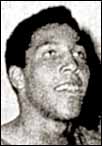 issues of the on-line New Canadian we've made substantial additions to the game reports on the 1952 Industrial League, especially for games involving the Vancouver Niseis. We also happened upon the year-end statistics for the Niseis. The Photo Gallery gets some new pics, transferred from the pages of the game reports (when we first began the game pages, there were so few photos we simply put them along with the game stories rather than on separate pages). That happens for 1956 as well. The 1951 Industrial League reports also get some additions.
issues of the on-line New Canadian we've made substantial additions to the game reports on the 1952 Industrial League, especially for games involving the Vancouver Niseis. We also happened upon the year-end statistics for the Niseis. The Photo Gallery gets some new pics, transferred from the pages of the game reports (when we first began the game pages, there were so few photos we simply put them along with the game stories rather than on separate pages). That happens for 1956 as well. The 1951 Industrial League reports also get some additions.
![]() From our lost now found department we've added in the rosters of the Duncan Senior League in 1945, another photo to the 1928 BC Snapshot page and we've added the 1942 BC Snapshot page with a couple of pics of veteran Coley Hall.
From our lost now found department we've added in the rosters of the Duncan Senior League in 1945, another photo to the 1928 BC Snapshot page and we've added the 1942 BC Snapshot page with a couple of pics of veteran Coley Hall.
![]() The 1946 BC Snapshot page is another new addition, with the one picture so far - a young Maw Mori, the teenage pitching phnom of the Slocan Valley during the internment years and later a long-time star in senior ball in Toronto.
The 1946 BC Snapshot page is another new addition, with the one picture so far - a young Maw Mori, the teenage pitching phnom of the Slocan Valley during the internment years and later a long-time star in senior ball in Toronto.
02 June, 2017
![]() There's even further documentation of the 1957 season as Rich Necker sends along details of the six-team Interior League of British Columbia. Rosters too. And, another epic for the Snapshots from the Quesnel Tournament.
There's even further documentation of the 1957 season as Rich Necker sends along details of the six-team Interior League of British Columbia. Rosters too. And, another epic for the Snapshots from the Quesnel Tournament.
![]() In researching the Vancouver Asahis, we came across an item in a 1939 issue of the New Canadian which provided a history, up to that point, of the famous West Coast nine. We've added the text to the 1939 home page. Among other things, it included an all-time Asahi All-Star team and provided an expanation of a second Asahi nine in 1921, the Asahi Tigers.
In researching the Vancouver Asahis, we came across an item in a 1939 issue of the New Canadian which provided a history, up to that point, of the famous West Coast nine. We've added the text to the 1939 home page. Among other things, it included an all-time Asahi All-Star team and provided an expanation of a second Asahi nine in 1921, the Asahi Tigers.
![]() A tad more detail is available on senior ball in Toronto. We've added game reports for the 1960 season of the Western City League. Rosters and the few stats are included.
A tad more detail is available on senior ball in Toronto. We've added game reports for the 1960 season of the Western City League. Rosters and the few stats are included.
01 June, 2017
![]() Those old editions of the New Canadian, the Japanese-Canadian journal, have produced some valuable additions to our baseball history project. The latest findings come from the 1956 season and cover mainly Japanese-Canadian ball in Vancouver, Kamloops, Lethbridge and Toronto.
Those old editions of the New Canadian, the Japanese-Canadian journal, have produced some valuable additions to our baseball history project. The latest findings come from the 1956 season and cover mainly Japanese-Canadian ball in Vancouver, Kamloops, Lethbridge and Toronto.
From the West Coast, there are additions to the game reports of the Industrial League involving the Vancouver Niseis. In the Interior, there's more about the North Kamloops Mohawks and the BC Interior circuit.
The Lethbridge Niseis and the Alberta Big Five League get expanded coverage and the Alberta Tournament reports are consolidated and organized.
Issues of the New Canadian provide reports on the Japanese team, Honest Ed's, in the Western City League and teams in the Toronto 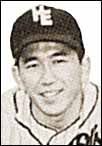 Nisei League. Among the unusual highlights - Negro Jim Franks, a mid-season pickup by Ed's, swatted three grand slam homers, and Nisei League hurler Frank Nishimura (left) fired three no-hitters. Moved up to Honest Ed's squad for the playoffs he nearly blew the opening game of the final walking five straight batters in the ninth and going 3-0 on the sixth before pumping three straight strikes to end the game.
Nisei League. Among the unusual highlights - Negro Jim Franks, a mid-season pickup by Ed's, swatted three grand slam homers, and Nisei League hurler Frank Nishimura (left) fired three no-hitters. Moved up to Honest Ed's squad for the playoffs he nearly blew the opening game of the final walking five straight batters in the ninth and going 3-0 on the sixth before pumping three straight strikes to end the game.
The reports helped us make some corrections to the names attached to the 1956 photo of the league champion Honest Ed's (Ken Braithwaite changed to Ken Breakwell, Bill Purcell as the unidentified player).
![]() 1957 gets even better with reports on the Prince George and District League thanks to Rich Necker. Among the stories, pitcher Ken Larsen. In his first seven starts with the Prince George Canadas Larsen went 0-6 with one no-decision. His last defeat came at the hands of Mike Church of the Willow River Red Sox who fired a no-hitter. Larsen, then switched to the Prince George Athletics and in his first start tossed a no-hitter !
1957 gets even better with reports on the Prince George and District League thanks to Rich Necker. Among the stories, pitcher Ken Larsen. In his first seven starts with the Prince George Canadas Larsen went 0-6 with one no-decision. His last defeat came at the hands of Mike Church of the Willow River Red Sox who fired a no-hitter. Larsen, then switched to the Prince George Athletics and in his first start tossed a no-hitter !
Rich also sends along information on the 1957 Quesnel Tournament and some individual photos of Okanagan players for the Photo Gallery, and even a couple of pictures for the Snapshots. And, to top it off, he's dug out some statistics for the Prince George loop.
![]() Additions to yearly home pages (1929 to 1931 and 1948 to 1959) reflect the discovery of new leagues or teams within leagues. Roster pages also show substantial additions, primarily 1929, 1930, 1931, 1948, 1952, 1953, 1955, 1956 and 1957. Rich managed to locate a few box scores from Vancouver Island ball in 1931 which has really helped to flesh out those roster sheets.
Additions to yearly home pages (1929 to 1931 and 1948 to 1959) reflect the discovery of new leagues or teams within leagues. Roster pages also show substantial additions, primarily 1929, 1930, 1931, 1948, 1952, 1953, 1955, 1956 and 1957. Rich managed to locate a few box scores from Vancouver Island ball in 1931 which has really helped to flesh out those roster sheets.
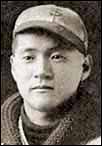 In the process we've made several hundred additions and deleted entries for several dozen as we consolidated the lists. For example there is the Doi family, prominent in the 1931 box scores noted above.
In the process we've made several hundred additions and deleted entries for several dozen as we consolidated the lists. For example there is the Doi family, prominent in the 1931 box scores noted above.
At one time we had entries for a half dozen with just the last name Doi and a position. Then there was a Ken Doi, a Kenichi Doi, a K. Doi, T. Doi, Fred Doi, Clifford Doi, Tadao Doi, Tadashi Doi, George Doi, and a Kenchy and a Tadao.
These all boil down to four players - Kenichi "Ken" Doi (the oldest brother, seen at the right), Tadao "Fred" Doi, Tadashi "Clifford" Doi and George Doi, Kenichi's son. For a time we thought the players listed as Kenchy and Tadao were different individuals, but it's clear from the team and the lineup that the papers listed one Doi, then the first names of the other Doi's in an apparent attempt to avoid confusion. Thanks to Joanne Doi for helping to sort out the family's baseball players !
![]() And, with the above changes we've updated the Player Lists right from 1900 through to 1979.
And, with the above changes we've updated the Player Lists right from 1900 through to 1979.
26 May, 2017
![]() Our dynamic duo is at it again with a result of more coverage of West Kootenay & Okanagan baseball in the late 1950s.
Our dynamic duo is at it again with a result of more coverage of West Kootenay & Okanagan baseball in the late 1950s.
Henry Ropertz and Rich Necker have searched out andproduced game reports, rosters and even a few photos and  snapshots from 1957 ball in the BC Interior. For those with anyconnection to the era, names such as Les Hufty (left), Loren Bay, Walt Avis and Irv Lavorato will be quite familiar.
snapshots from 1957 ball in the BC Interior. For those with anyconnection to the era, names such as Les Hufty (left), Loren Bay, Walt Avis and Irv Lavorato will be quite familiar.
![]() Our look into the New Canadian newspaper has led to some interesting findings, as we follow some of the Japanese players across the country.
Our look into the New Canadian newspaper has led to some interesting findings, as we follow some of the Japanese players across the country.
Taken from their homes and businesses and forced into internment camps during the Second World  War, they were then compelled to move away from the coast after war. It resulted in the formation of Nisei baseball in Winnipeg, Fort William, Port Arthur, Hamilton, Toronto and Montreal. Former Vancouver Asahi stars such as Roy Yamamura, Reggie Yasui, Ken Kutsukake (left) and Ty Suga took their game to Eastern diamonds.
War, they were then compelled to move away from the coast after war. It resulted in the formation of Nisei baseball in Winnipeg, Fort William, Port Arthur, Hamilton, Toronto and Montreal. Former Vancouver Asahi stars such as Roy Yamamura, Reggie Yasui, Ken Kutsukake (left) and Ty Suga took their game to Eastern diamonds.
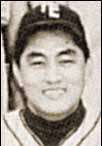 And, we followed the career of young Massme "Maw" Mori (right), a lefty hurler who began to attract attention as a 15-year-old while pitching for junior, intermediate and senior teams while in an internment camp in the Slocan Valley.
And, we followed the career of young Massme "Maw" Mori (right), a lefty hurler who began to attract attention as a 15-year-old while pitching for junior, intermediate and senior teams while in an internment camp in the Slocan Valley.
Mori, who relocated to Toronto, became a star in local ball there, first as a pitcher, then, after arm woes, a slugging first baseman. He suited up for both baseball and softball teams playing into the early 1960s. Mori, a talented all-around athlete, also went on to become a star in bowling, good enough to be inducted into a bowling Hall of Fame.
![]() After several weeks of much frustration and many setbacks (most self-inflicted), we've finally posted updates to the Western Canada Player Lists. These now include about 1,300 new names and make note of additional data on about 2,700 other players covering the period from 1900 to 1979.
After several weeks of much frustration and many setbacks (most self-inflicted), we've finally posted updates to the Western Canada Player Lists. These now include about 1,300 new names and make note of additional data on about 2,700 other players covering the period from 1900 to 1979.
20 May, 2017
![]() Alberta, 1957 gets a little more attention as we add in more photos from another package from Henry Ropertz. The pics show up in the Snapshots and Photo Gallery along with several updated photos, including Pat Gillick.
Alberta, 1957 gets a little more attention as we add in more photos from another package from Henry Ropertz. The pics show up in the Snapshots and Photo Gallery along with several updated photos, including Pat Gillick.
![]() Much time taken lately working to update the Player Lists. It is hoped an updated edition will be posted within the week.
Much time taken lately working to update the Player Lists. It is hoped an updated edition will be posted within the week.
19 May, 2017
![]() Oh what an understatement. Mark Syme of Chemainus, BC, sent along photos of some Vancouver Island teams noting he had no idea if they would be a fit for our site. Well, we are overjoyed to have them - the 1939 Chemainus Longshoremen, 1948 Duncan Athletics and 1954 Chemainus Red Sox. Thank you Mark !
Oh what an understatement. Mark Syme of Chemainus, BC, sent along photos of some Vancouver Island teams noting he had no idea if they would be a fit for our site. Well, we are overjoyed to have them - the 1939 Chemainus Longshoremen, 1948 Duncan Athletics and 1954 Chemainus Red Sox. Thank you Mark !
![]() More additions to 1957 Arrow Lakes / Slocan baseball thanks to Rich Necker. He's provided more game reports and rosters along with the addition of a snippet and rosters on the West Kootenay Junior League.
More additions to 1957 Arrow Lakes / Slocan baseball thanks to Rich Necker. He's provided more game reports and rosters along with the addition of a snippet and rosters on the West Kootenay Junior League.
Henry Ropertz and Rich have also been scouring 1957 papers for more on Alberta baseball and we are please to post additions in the Alberta Snapshot page and the Tournament page. Also, several of the 1957 WCBL snapshots have been redone given access to slightly better newspaper photos.
![]() Sixty years later, ten survivors of the 1957 California Junior College champions were saluted and cheered at Sequoias College in Visalia last month. We've noted this occasion previously, but did not have names for the photo of the event. Thanks to Bob Craine of COS, we now have the IDs along with a second photo of the group (check the bottom of the Sequoias page).
Sixty years later, ten survivors of the 1957 California Junior College champions were saluted and cheered at Sequoias College in Visalia last month. We've noted this occasion previously, but did not have names for the photo of the event. Thanks to Bob Craine of COS, we now have the IDs along with a second photo of the group (check the bottom of the Sequoias page).
![]() Hank Weaver, former hurler for the Moose Jaw Maples, passed away May 5th in Phoenix. Weaver was 95. The right-hander had a brief spin with Moose Jaw in 1952.
Hank Weaver, former hurler for the Moose Jaw Maples, passed away May 5th in Phoenix. Weaver was 95. The right-hander had a brief spin with Moose Jaw in 1952.
![]() The team photo of the Colville, WA, squad that we thought was the 1931 edition, now (with a comparison of the rosters year by year) seems to be the 1932 team. Appropriate changes made.
The team photo of the Colville, WA, squad that we thought was the 1931 edition, now (with a comparison of the rosters year by year) seems to be the 1932 team. Appropriate changes made.
17 May, 2017
![]() The New Canadian newspaper of the 1940s and 1950s has produced some unexpected gems. Made available on-line by Simon Fraser University of Vancouver, the paper provides coverage of Japanese baseball teams in Vancouver, the BC Interior, Raymond, Lethbridge, Winnipeg, Hamilton, Toronto and Montreal.
The New Canadian newspaper of the 1940s and 1950s has produced some unexpected gems. Made available on-line by Simon Fraser University of Vancouver, the paper provides coverage of Japanese baseball teams in Vancouver, the BC Interior, Raymond, Lethbridge, Winnipeg, Hamilton, Toronto and Montreal.
We've begun to delve into the material and have first tried to document the various leagues. Thus, the home pages have been updated from 1939-1940-1941 and 1946 through to 1959 with the leagues we've uncovered so far. For a few seasons, 1939, 1940,  1949, 1952 and 1955 we've managed to add to the rosters.
1949, 1952 and 1955 we've managed to add to the rosters.
We are hoping to trace the movement of various Vancouver Asahi stars as they fanned out across the country after being released from detention camps during the war and forced to relocate from the West Coast. For example, Ty Suga (left) founded the Asahi team in Montreal and brother Kiyoshi was one of the players. Roy Yamamura was with the Hamilton club and Ken Kutsukake was manager of the Toronto Westerns and later, the Honest Ed's entry. (See the photos noted below).
For 1940, we've expanded the game reports to clearly demonstrate Japanese baseball was far more than the celebrated Asahis.
There was the VANCOUVER JAPANESE LEAGUE with the Asahi Giants, Powell Drugs, Steveston Fuji, and Union Fish.
And, the VANCOUVER BUSSEI LEAGUE represented by Fairview, Hompa, and Kitsalano.
Then a VANCOUVER JAPANESE INTER-CITY LEAGUE featuring Kitsilano Kyuhlins, Mikado, and Westminster Taikus.
The FRASER VALLEY LEAGUE featured Ladner Blue Bombers, Riverside JCCL, Taiiku Giants and Taiiku Juniors.
The WOODFIBRE BASEBALL LEAGUE had four clubs, Bull Gang, Cardinals, Eagles, and Machine Room.
These findings sent us on a search for photographic evidence and we are pleased to post team pictures of the 1949 Montreal Niseis and the 1948 Hamilton Niseis. There is the 1950 group photo of the Toronto Westerns and one of Honest Ed's Toronto club of 1956.
![]() Thanks to Bob Needham (whose dad Vince played for Carmangay) for sending along some photos of players from the late 1940s and early 1950s Carmangay clubs. Catcher Roy McLeod is featured while we continue to chase a good photo of star hurler Bob Shearer.
Thanks to Bob Needham (whose dad Vince played for Carmangay) for sending along some photos of players from the late 1940s and early 1950s Carmangay clubs. Catcher Roy McLeod is featured while we continue to chase a good photo of star hurler Bob Shearer.
![]() And kudos to Mark Syme of Chemainus, BC, for photos of teams from Chemainus and Duncan. We're still working on those and hope to have them posted in few days. Thankfully, Mark's note also helps us do away with our Syme/Symes spelling. The papers of the day used both, frequently. The photos will show Mark's grandfather, great-grandfather and two uncles!
And kudos to Mark Syme of Chemainus, BC, for photos of teams from Chemainus and Duncan. We're still working on those and hope to have them posted in few days. Thankfully, Mark's note also helps us do away with our Syme/Symes spelling. The papers of the day used both, frequently. The photos will show Mark's grandfather, great-grandfather and two uncles!
04 May, 2017
![]() Our featured correspondents, the honourable members Rich Necker and Henry Ropertz have joined forces to dig out some details on the 1937 season of baseball in the West Kootenays and (because Trail was in the loop) the Eastern Washington League (yep, West Kootenays,. East Washington). Along with the game reports, lots of additions to the roster page.
Our featured correspondents, the honourable members Rich Necker and Henry Ropertz have joined forces to dig out some details on the 1937 season of baseball in the West Kootenays and (because Trail was in the loop) the Eastern Washington League (yep, West Kootenays,. East Washington). Along with the game reports, lots of additions to the roster page.
Many familiar names -- Pills Purcello, Rube DeMore, Cliff Bogstie, Rusty Wynn.
![]() You have to check out Brian Morrison's (Diamonds in the Dusk) piece on Frank Juney, a bright star of 1919 baseball on the prairies.
You have to check out Brian Morrison's (Diamonds in the Dusk) piece on Frank Juney, a bright star of 1919 baseball on the prairies.
While beginning to learn how to pitch (he came up to play with Moose Jaw as a third baseman) Juney fashioned an eye-opening 20-4 summer hurling for eight different teams under three different names (Juney or Giugni or Guigni). The highlight of his season as a pitcher-in-training was a double-header in Maple Creek when he tossed two complete game shutouts, fanning a total of 42 batters. The first game was a 4-0, no-hitter with 24 strikeouts. He relaxed in the second game, an 8-0, two-hit, shutout with 18 whiffs.
![]() So nice to hear from Valerie Lowe (Hayashi), Nobby's youngest daughter noting the lovely service for her dad in New Denver. Nobby had such a positive impact in the community and will be sorely missed by so many.
So nice to hear from Valerie Lowe (Hayashi), Nobby's youngest daughter noting the lovely service for her dad in New Denver. Nobby had such a positive impact in the community and will be sorely missed by so many.
![]() Thanks to Greg Nesteroff, well-known West Kootenay journalist and historian, for sending along some stats for the 1949 New Denver baseball team. These include all the games played by the club, not just the regular league contests. We're still trying to determine the first names of several of the players -- George E. , Hagoshi N. , Hiyahara K., Kireto N. , Kondo T., Mori H., Powell D., and Trayama S.
Thanks to Greg Nesteroff, well-known West Kootenay journalist and historian, for sending along some stats for the 1949 New Denver baseball team. These include all the games played by the club, not just the regular league contests. We're still trying to determine the first names of several of the players -- George E. , Hagoshi N. , Hiyahara K., Kireto N. , Kondo T., Mori H., Powell D., and Trayama S.
Also, I have these guys listed as separate players, but have the feeling they are the same guy -- Saruyama W. OF, Suryama Chris(Wahoo).
![]() Jeremy Klaszus, who is doing some really interesting journalism (not just baseball), is looking for pictures of the old ballparks in Calgary. I brought his attention to one of the few I have of old Buffalo Stadium (sent along by Jack Altman) but now note the lack of photos of Calgary's former ball diamonds. Any chance you might have photos in some of your old albums?
Jeremy Klaszus, who is doing some really interesting journalism (not just baseball), is looking for pictures of the old ballparks in Calgary. I brought his attention to one of the few I have of old Buffalo Stadium (sent along by Jack Altman) but now note the lack of photos of Calgary's former ball diamonds. Any chance you might have photos in some of your old albums?
![]() And, a thank you to Geri Prior, whose dad Elmer Mori was quite the player in the 1950s with clubs in Penticton and Vancouver. I had asked Geri to check out whether any of a a half-dozen other players with the same last name might be related to Elmer. Turns out, no.
And, a thank you to Geri Prior, whose dad Elmer Mori was quite the player in the 1950s with clubs in Penticton and Vancouver. I had asked Geri to check out whether any of a a half-dozen other players with the same last name might be related to Elmer. Turns out, no.
![]() We're continuing to try and complete our report on the 1935 tour of the USA and Western Canada by the Japanese squad to be known as the Tokyo Giants. We're awaiting details on four or five of the more than 100 games played.
We're continuing to try and complete our report on the 1935 tour of the USA and Western Canada by the Japanese squad to be known as the Tokyo Giants. We're awaiting details on four or five of the more than 100 games played.
![]() Thanks to all for the feedback on the piece on Black players in Canada on the New York City based Narratively site. Neat.
Thanks to all for the feedback on the piece on Black players in Canada on the New York City based Narratively site. Neat.
![]() Whew. Work proceeds on trying to update the Player Lists. The master spreadsheet now has many hundred new entries. Now to get to putting together the various compilations. This may wait until we check out some finds in the New Canadian newspaper covering Japanese baseball in 1939, 1940, 1941 and 1956. These recently discovered articles may help provide some background on such clubs as the Steveston Fuji and Vancouver Nisei.
Whew. Work proceeds on trying to update the Player Lists. The master spreadsheet now has many hundred new entries. Now to get to putting together the various compilations. This may wait until we check out some finds in the New Canadian newspaper covering Japanese baseball in 1939, 1940, 1941 and 1956. These recently discovered articles may help provide some background on such clubs as the Steveston Fuji and Vancouver Nisei.
21 April, 2017
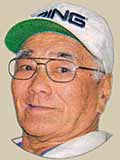
![]() Nobuyoshi "Nobby" Hayashi, a fixture in New Denver and area since the late 1940s, passed away April 1st at the age of 89.
Nobuyoshi "Nobby" Hayashi, a fixture in New Denver and area since the late 1940s, passed away April 1st at the age of 89.
Nobby was known throughout the area for his years of volunteering at the Nikkei Internment Memorial Centre and for his deep interest in baseball. Nobby suited up for New Denver and its combined teams with Silverton and Nakusp. He also spent a summer playing for the Lethbridge Niseis. A Celebration of Life will be held Saturday at one o'clock at the Bosun Hall, New Denver.
![]() Thanks to Bob Craine at the College of Sequoias, Visalia, California, for sending along word of the 60th anniversary celebration of the state championship season of 1957.
Thanks to Bob Craine at the College of Sequoias, Visalia, California, for sending along word of the 60th anniversary celebration of the state championship season of 1957.
A number of the '57 team were present to be saluted by the fans during a special ceremony. Bob has included a photo of the event (which is also posted on the Sequoias page) with names to come.
COS was a prime source of players for Western Canada Baseball in the 1950s. These guys would now be in the late 70s and early 80s. Left to right - Thurman Zearley, Bill Key, Ted Hiltel, Glen McMillan, Jim Garrett, Joe Hernandez, Marv Weekly, Art Browning, Paul Morrison and Frank Alves.

16 April, 2017
![]() Hope you'll check out this baseball history treat on the New York City based Narratively site.
Hope you'll check out this baseball history treat on the New York City based Narratively site.
Over the past couple of weeks I've worked with writer Michael Stahl to help on a story about the rush of black baseball players to Canada in the late 1940s and early 1950s after the collapse of the Negro Leagues in the USA. Too short, of course, (they wouldn't have enough storage capacity for a length of our choosing !) but further confirmation of the interest and worth of our little effort here. Congrats Michael ! Nicely done.
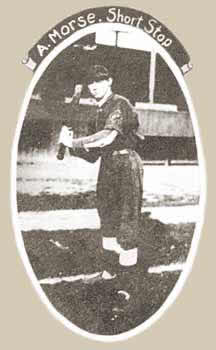
![]() We've added the rest of the individual cutouts of the 1921 Hanbury Lumbermen from a team composite provided by Gary Daniels, the grandson of the captain of the champion squad.
We've added the rest of the individual cutouts of the 1921 Hanbury Lumbermen from a team composite provided by Gary Daniels, the grandson of the captain of the champion squad.
That's shortstop Art Morse, left, who went on to a long career in the Vancouver Senior League.
![]() A few bits and pieces added to our image collection, including Cecil Thompson in 1912 and Irvin Castille in 1952.
A few bits and pieces added to our image collection, including Cecil Thompson in 1912 and Irvin Castille in 1952.
![]() We're happy to finally catchup and post some team pictures, all BC nines - Victoria Bees 1912, Nakusp 1912, Oyama 1928, and Moyie 1908,
We're happy to finally catchup and post some team pictures, all BC nines - Victoria Bees 1912, Nakusp 1912, Oyama 1928, and Moyie 1908,
And, we've filled in the stats for a couple of major leaguers, Jerry Freeman and Ike Rockenfield a pair who made it up to the show from a start in Vancouver in 1902. Still some work ahead to add details on their careers.
![]() Our Rich Necker, the former Trail baseballer, has reached out to contacts in the Bay family to sort out the family's baseball history. Of course, you're aware of Jason Bay the former National League Rookie of the Year who went on to an 11-year career in the majors, belting 222 home runs on the way to three All-Star appearances.
Our Rich Necker, the former Trail baseballer, has reached out to contacts in the Bay family to sort out the family's baseball history. Of course, you're aware of Jason Bay the former National League Rookie of the Year who went on to an 11-year career in the majors, belting 222 home runs on the way to three All-Star appearances.
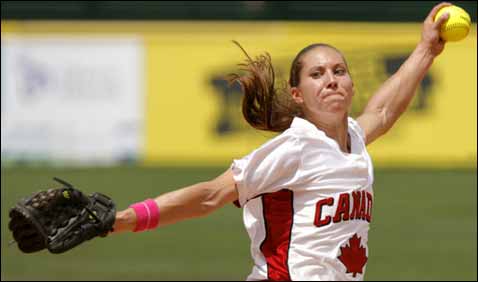 And, you must have heard of Jason's sister Lauren, a superstar in her own right - a college All-American and standout lefty hurler for Team Canada, including Canada's Olympic softball team. And, she played pro ball too with the Chicago Bandits and Philadelphia Force.
And, you must have heard of Jason's sister Lauren, a superstar in her own right - a college All-American and standout lefty hurler for Team Canada, including Canada's Olympic softball team. And, she played pro ball too with the Chicago Bandits and Philadelphia Force.
Jason's dad, Dave, played minor ball in Trail in the early and mid 1970s, while Jason's grandfather Len, was one of three Bay brothers, along with Loren and Elmer, who were ball stars in the Kootenays in the 1940s and 1950s.
We did have a spelling as Lorne Bay, but that's now been corrected throughout the site (to Loren Bay).
![]() I think it's the first time I've been really disappointed by a public library, either in Canada or the USA. Until now, these folks have been just marvelous in assisting in my many requests for information over the years going well and beyond at times to dig out, in the main, newspaper clippings on baseball.
I think it's the first time I've been really disappointed by a public library, either in Canada or the USA. Until now, these folks have been just marvelous in assisting in my many requests for information over the years going well and beyond at times to dig out, in the main, newspaper clippings on baseball.
Well, then there's the Flint, Michigan, Public Library. First of all, it's still in the dark ages. No on-line access. One cannot even post requests on-line. Nope, you must print out the requisition form, include payment and mail, that's post office mail, the request. Well, I made my request for the game story and boxscore of a game played on June 7th, 1935. After a couple of weeks, I got the reply (in the post office mail). There it was all the pre-game reports carried in the papers of June 7th, but nothing on the actual game. They didn't bother to check the paper of June 8th for the game story or boxscore. It's just such a shock. I guess it was just an off-day for one of the librarians. Back to the drawing board.
This is all part of the effort to compile a comprehensive report on the 1935 tour of the Dai Nippon Japanese All-Stars to the States and Canada. So far we have a list of all 109 games, but we are missing five in which we cannot determine the winning or losing pitcher.
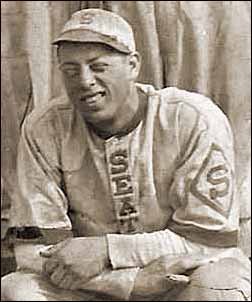
![]() A little more Frank Juney before we leave 1919. (Left - that's Juney/Guigni/Giugni in 1915 when with Seattle.)
A little more Frank Juney before we leave 1919. (Left - that's Juney/Guigni/Giugni in 1915 when with Seattle.)
We've discovered one more team which employed the pitcher-in-training during that 1919 season (Juney, real name Guigni/Giugni, had started the season as an infielder with Moose Jaw). The latest find is Lethbridge. That makes eight teams for Juney in less than four months of 1919, Lethbridge, Moose Jaw, Calgary, Barons, Nick Williams' All-Stars, Oyen, Burdett, and Maple Creek.
We now list 28 games as a pitcher, 23 starts, 23 complete games, 20-4. The information below and on the Snapshot page has been changed to match the new figures. And, while his progress as a pitcher was remarkable, he may well have been more important as a hitter during his wild summer on the prairies.
![]() Former Lloydminster Meridian David Moriarty continues to make progress during a long DL stint (broken leg, hip). Had a long chat with David as we continue to try and locate other members of those Lloydminster teams in the 1950s. Among the outstanding names - Don Kuodis and Marty Stillman. Both seem to have disappeared off the face of the planet.
Former Lloydminster Meridian David Moriarty continues to make progress during a long DL stint (broken leg, hip). Had a long chat with David as we continue to try and locate other members of those Lloydminster teams in the 1950s. Among the outstanding names - Don Kuodis and Marty Stillman. Both seem to have disappeared off the face of the planet.
![]() A big round of applause for Melissa Franks. I don't know if she ever played baseball or even showed any interest, but we know she's special. A week or two back, Melissa received a call from an Elmer Mori, former ball player for Kamloops and Vancouver Japanese teams. Elmer was trying to contact Merv Franks a former teammate as part of an effort to write a history of the Vancouver Nisei team of the 1950s. He got the wrong "M. Franks". Melissa could have simply informed the 84-year-old Mr. Mori than he had the wrong number. Well, she did that, but much, much more. She took on Elmer's chore to try and contact his former teammates. As part of that effort she reached us to put together some rosters and provide more names for Elmer and to find some specific baseball events to help jog Elmer's memory about the old times. They still haven't met, but hope to have lunch this week. What a lovely gesture.
A big round of applause for Melissa Franks. I don't know if she ever played baseball or even showed any interest, but we know she's special. A week or two back, Melissa received a call from an Elmer Mori, former ball player for Kamloops and Vancouver Japanese teams. Elmer was trying to contact Merv Franks a former teammate as part of an effort to write a history of the Vancouver Nisei team of the 1950s. He got the wrong "M. Franks". Melissa could have simply informed the 84-year-old Mr. Mori than he had the wrong number. Well, she did that, but much, much more. She took on Elmer's chore to try and contact his former teammates. As part of that effort she reached us to put together some rosters and provide more names for Elmer and to find some specific baseball events to help jog Elmer's memory about the old times. They still haven't met, but hope to have lunch this week. What a lovely gesture.
26 March, 2017
![]() One more example of "do not assume" !
One more example of "do not assume" !
 Back in December we posted a story about the amazing 1963 season Bill Cundiff had with the St. Lazare Athletics of the Manitoba Senior Baseball League. The left-hander had had a very disappointing rookie season in pro ball in 1961 going 0-8 with three teams in the St. Louis Cardinals farm system. The following season, that record went to 0-11 before he managed to break through with a win en route to a 5-11 campaign. He began 1963 in the pro ranks with Winnipeg Goldeyes of the Northern League but was released after just two games. He stayed in the Winnipeg area suiting up with St. Lazare and dazzled as the league's top hurler with nine wins in thirteen decisions. He racked up 170 strikeouts in just 106 innings and allowed just 47 hits.
Back in December we posted a story about the amazing 1963 season Bill Cundiff had with the St. Lazare Athletics of the Manitoba Senior Baseball League. The left-hander had had a very disappointing rookie season in pro ball in 1961 going 0-8 with three teams in the St. Louis Cardinals farm system. The following season, that record went to 0-11 before he managed to break through with a win en route to a 5-11 campaign. He began 1963 in the pro ranks with Winnipeg Goldeyes of the Northern League but was released after just two games. He stayed in the Winnipeg area suiting up with St. Lazare and dazzled as the league's top hurler with nine wins in thirteen decisions. He racked up 170 strikeouts in just 106 innings and allowed just 47 hits.
Then, as we noted in December, the trail went cold. But, a note from former Canadian hurler Steve Cottrell (Vulcan 1961-62) brought our attention to a Bill Cundiff having a remarkable season pitching in a city league in El Paso, Texas in 1965. A no-hitter and a 23-strikeout game were among the achievements. For what I managed to dig up from newspaper accounts, Cundiff in El Paso, racked up an 11-0 record with 185 strikeouts in just 89 innings. This looked pretty similar to the Bill Cundiff in St. Lazare in 1963.
Further, it turned out Bill Cundiff (of St. Lazare) had been drafted into the army and had been posted to ... El Paso, Texas ! So, just had to be the same guy. right? Well, no. Yes, there was a Bill Cundiff pitching in El Paso, but for the US Army team at Fort Bliss. The other Bill Cundiff was pitching in the city league. Two Bill Cundiffs, unaware of each other, pitching in El Paso, perhaps in the same ballpark, in the summer of 1965.
Finally, I tracked down Bill (St. Lazare) Cundiff in Arenzville, Illinois, to confirm the story. He was surprised to hear of the exploits of the "other" Bill Cundiff. He didn't play much after his army stint, playing a little ball back in his home state over the next few years recognizing that the summer of 1963 in St. Lazare, Manitoba, had been a highlight of his baseball career.
![]() Our correspondents continue to amaze. Rich Necker brings us league game details, tournaments, and rosters from BC Interior ball in 1956. Henry Ropertz is wrapping up his work on the famous 1935 tour of North America by Dai Nippon, the team which morphed into the first pro baseball team in Japan, becoming the Tokyo Giants. We are still awaiting some material on five or six of the 109 games to try and determine the pitching records of the Japanese hurlers, especially future Hall Famers, Eiji Sawamura and Victor Starffin. So far, we show Sawamura with a sparkling 23-9 record in an eye-popping 48 games (of a 109 game tour), 27 starts, 21 in relief.
Our correspondents continue to amaze. Rich Necker brings us league game details, tournaments, and rosters from BC Interior ball in 1956. Henry Ropertz is wrapping up his work on the famous 1935 tour of North America by Dai Nippon, the team which morphed into the first pro baseball team in Japan, becoming the Tokyo Giants. We are still awaiting some material on five or six of the 109 games to try and determine the pitching records of the Japanese hurlers, especially future Hall Famers, Eiji Sawamura and Victor Starffin. So far, we show Sawamura with a sparkling 23-9 record in an eye-popping 48 games (of a 109 game tour), 27 starts, 21 in relief.
Henry has also located the newspaper story of the photo (see below) of some of the pitchers of the 1912 Victoria Bees of the Northwestern League. Unfortunately, the names in the paper confound the issue even more as the player seemingly related to Bob Hitchman, who brought the picture to our attention, is identified as another player, not the one Bob thought it might be. More to come.
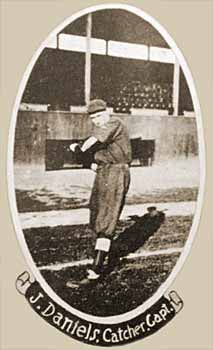
![]() We added a better quality photo of the 1921 Terminal League and Vancouver City champion Hanbury Lumbermen nine thanks to Gary Daniels, grandson of the catcher on the 1921 team, John "Red" Daniels. We're still working on IDs for the new image. Also, from Gary, pictures of the individual players from a team composite photo. I've finished three so far and they're posted on the Hanbury page.
We added a better quality photo of the 1921 Terminal League and Vancouver City champion Hanbury Lumbermen nine thanks to Gary Daniels, grandson of the catcher on the 1921 team, John "Red" Daniels. We're still working on IDs for the new image. Also, from Gary, pictures of the individual players from a team composite photo. I've finished three so far and they're posted on the Hanbury page.
![]() The discovery of some on-line papers from Coquitlam and a book on baseball in Colville, WA, enabled us to gather and post rosters for teams in the Dewdney/Triangle Leagues and Kootenay ball for 1929, 1930, 1932, 1933, 1934, 1935 and 1937.
The discovery of some on-line papers from Coquitlam and a book on baseball in Colville, WA, enabled us to gather and post rosters for teams in the Dewdney/Triangle Leagues and Kootenay ball for 1929, 1930, 1932, 1933, 1934, 1935 and 1937.
![]() The Colville book is the source of our new team photo of Colville, 1932. The members would have been familiar to Southern BC ball fans from the club's frequent trips across the border to take on Canadian competition.
The Colville book is the source of our new team photo of Colville, 1932. The members would have been familiar to Southern BC ball fans from the club's frequent trips across the border to take on Canadian competition.
Another newly added team photo is the 1930 edition of the Fraser Mills squad.
![]() Thanks to Lianne, the granddaughter of "Stiffy" Lewis we have more information on Clifford Gordon "Stiffy" Lewis. We can now attempt to put together the history of the family (which, if seems, moved from Duluth, MN to Nova Scotia before the family, or at least portions of, settled in Calgary).
Thanks to Lianne, the granddaughter of "Stiffy" Lewis we have more information on Clifford Gordon "Stiffy" Lewis. We can now attempt to put together the history of the family (which, if seems, moved from Duluth, MN to Nova Scotia before the family, or at least portions of, settled in Calgary).
![]() And, Jane Shury (CEO of the Saskatchewan Baseball Hall of Fame) noted an omission to Terry Puhl's record noted here, that he had been inducted into the Saskatchewan Baseball Hall of Fame in 1993. Thanks Jane.
And, Jane Shury (CEO of the Saskatchewan Baseball Hall of Fame) noted an omission to Terry Puhl's record noted here, that he had been inducted into the Saskatchewan Baseball Hall of Fame in 1993. Thanks Jane.  Now updated.
Now updated.
![]() Michael Stahl, a New York writer, is working on a story on the influx of black players to Canada in the late 1940s and early 1950s after Jackie Robinson's intergation of the majors led to the demise of the Negro Leagues. We've been happy to help out on the story.
Michael Stahl, a New York writer, is working on a story on the influx of black players to Canada in the late 1940s and early 1950s after Jackie Robinson's intergation of the majors led to the demise of the Negro Leagues. We've been happy to help out on the story.
Through Michael we've learned of the death, just three months ago, of Orlando "Chico" O'Farrill, one of the many players from the Negro Leagues to suit up in Western Canada. O'Farrill (right) played Negro League ball with the Indianapolis Clowns, Philadelphia Stars and Baltimore Elite Giants. The speedy shortstop, from from Havana, Cuba, played in Eston and North Battleford, Saskatchewan, in the early 1950s and went on to a long, long career coaching in Nicaragua. He was a fixture on the diamonds there for more than 50 years. O'Farrill was 94.
24 February, 2017

![]() Leonard John Breckner was one of the best of the local athletes to grace the diamonds of the Western Canada League.
Leonard John Breckner was one of the best of the local athletes to grace the diamonds of the Western Canada League.
Breckner died November 27th a day after his 84th birthday. .
I last had an opportunity to meet with Len in 2010 at the Hall of Fame induction dinner in Battleford (that's Len on the right). He was a major force in prairie ball over two decades from the late 1940s to the late 1960s. The first baseman-outfielder began his career playing for home town Colonsay, and attracted plenty of interest.
"Have seen a lot of good young ball players around Saskatoon and district this summer but none more impressive than 16-year-old Len Breckner, currently playing third base for the senior Colonsay Monarchs. Tall and graceful in movement, young Breckner fairly oozes with natural baseball ability. Right now he's a better fielder than hitter, but plays well enough as both hitter and fielder to perform with most senior clubs. Al Pendleton, a close diamond observer from Colonsay, figures Breckner for big things in the baseball world in about four years. (Saskatoon Star-Phoenix, July 18, 1949)
At 18, he was among a few local kids to be selected to attend baseball camps in California. In 1952, at age 19, he he suited up for the Saskatoon Gems of the Saskatchewan League hitting .263 and .260 in his first two years before breaking out, albeit in part time duty, with a .409 mark in 1954. Playing in the Western Canada League alongside top rated American college players destined for major league careers, former Negro League stars and a few former pro baseballers, Breckner more than held his own batting .326 in 1955, as a 22-year-old, .316 in 1957 and .328 in 1959.
Len, a first-class gentleman, was inducted into the Saskatchewan Baseball Hall of Fame in 1990 and into the Saskatoon Sports Hall of Fame in 2009.
![]() A whole bunch of photos added :
A whole bunch of photos added :
... individual photos 1925 (Porky Dallas, Hap Felsch, Swede Risberg, Chief Eastman), 1934, a new page (including Stan Hambly), 1948 (Lowell Hanson, Bill Gatenby), 1958 (Fred Scott), 1959 (James Sims LHP, Ray Sims RHP, one from Arizona State the other, Pepperdine), 1959 (Oscar Tesch), 1959 Minnesota (Clem Ozburn, George Dropo, et al), 1960 (Ben Burnett), 1960 Minnesota (Larry Klunder, Larry Bohannon, Jerry Splinter et al).
... snapshots 1948 (Bill Gatenby), 1960 (Ray Wrenn),
... team 1925, Scobey, Montana powerhouse, including former major leaguers Hap Felsch, Swede Risberg.
... team 1947, San Francisco Sea Lions, a West Coast Negro League team which toured in Western Canada (unfortunately, no names available).
... game reports 1935 (BC Interior), 1937 (BC Interior), 1947 (BC Interior) thanks to Rich Necker.
... 1921, image of the league schedule, thanks to David S. Eskenazi.
... 1914 home page, to reflect the batting championship for Peggy Barth ...
... rosters, 1935, 1937, 1947 for the BC material, and for the 1935 Brewster, WA, nine. The Spokane paper ran an item noting the team's 30 consecutive victories and kindly printed a team roster (with a good number of first names).
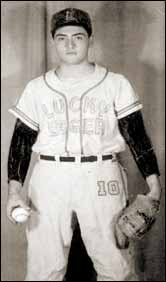
![]() Wait'll Connie Munatones sees this one! Stumbled upon a photo of the former Western Canada League star during his high school days. Yes, he was a pitcher back in those days, here, at age 16, for the "barrio team" Lucky Lagers. The photo is from the book Mexican American Baseball in Los Angeles. Munatones was a high school teammate of another WCBL star, Ernie Rodriguez.
Wait'll Connie Munatones sees this one! Stumbled upon a photo of the former Western Canada League star during his high school days. Yes, he was a pitcher back in those days, here, at age 16, for the "barrio team" Lucky Lagers. The photo is from the book Mexican American Baseball in Los Angeles. Munatones was a high school teammate of another WCBL star, Ernie Rodriguez.
![]() Hilton A.C. ? Terry Ducar writes from Florida that he's interested in discovering the history of an old aluminium cup he picked up at a yard sale. The inscription reads "S.M.B.L. 1938-39, HILTON, A.C.". Terry thought it might have something to do with Saskatchewan, but I can't unearth any connection. Southern Minnesota? The only Hilton link I could find was a baseball team in New York in the late 1930s. Ideas?
Hilton A.C. ? Terry Ducar writes from Florida that he's interested in discovering the history of an old aluminium cup he picked up at a yard sale. The inscription reads "S.M.B.L. 1938-39, HILTON, A.C.". Terry thought it might have something to do with Saskatchewan, but I can't unearth any connection. Southern Minnesota? The only Hilton link I could find was a baseball team in New York in the late 1930s. Ideas?
![]() Researcher Chadwick Crawford is trying to find a way to honour former Negro leaguer Irvin Castille (who played a season in the ManDak League in 1952) and apparently grew up in the same neighbourhood as Chadwick in Lafayette,Louisiana. We're searching for a good photo of the infielder, but our best lead (a picture in the Brandon Sun) has washed out as no original photo is available and the microfilm version is of extremely poor quality.
Researcher Chadwick Crawford is trying to find a way to honour former Negro leaguer Irvin Castille (who played a season in the ManDak League in 1952) and apparently grew up in the same neighbourhood as Chadwick in Lafayette,Louisiana. We're searching for a good photo of the infielder, but our best lead (a picture in the Brandon Sun) has washed out as no original photo is available and the microfilm version is of extremely poor quality.
![]() We're also on the lookout for information on the 1912 Victoria, BC, Bees of the Northwestern League. Bob Hitchman was sorting through some of his great grandmother's photographs and came across a photo of a group of the team members which included a relative, first name Roy or Ray, last name unknown, but perhaps Keppeler or Abbott. The photo was one of those photo postcards of the era, and I managed to track down the address and discover a Frank Abbott lived at the location, but no Frank or Ray or Roy Abbott listed with the team.
We're also on the lookout for information on the 1912 Victoria, BC, Bees of the Northwestern League. Bob Hitchman was sorting through some of his great grandmother's photographs and came across a photo of a group of the team members which included a relative, first name Roy or Ray, last name unknown, but perhaps Keppeler or Abbott. The photo was one of those photo postcards of the era, and I managed to track down the address and discover a Frank Abbott lived at the location, but no Frank or Ray or Roy Abbott listed with the team.
The photo (below) appears to be of the pitchers of the team, taken in San Jose, California. So this could be at spring training. Roy/Ray is the guy second from the right. Hard to tell if he's a right-hander or lefty. More detective work to be done ! Once our Henry Ropertz is wrapped up with his opus on the 1935 tour of the US and Canada by the Tokyo Giants, we'll see if he can dig up anything in the Victoria papers.
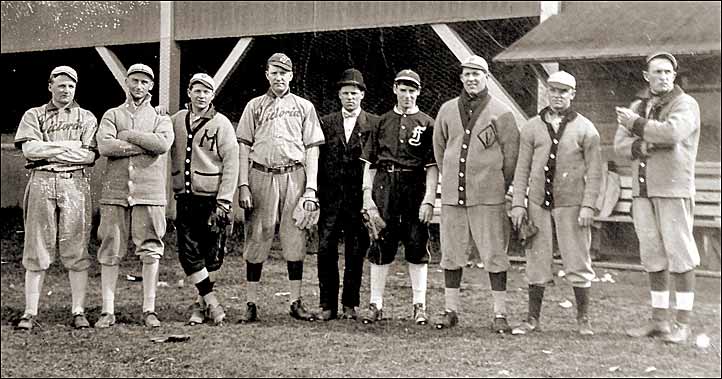
![]() Kudos to Catherine of the Courtenay Museum ! We were after a newspaper report on one of the those games by the Tokyo Giants in BC in 1935. And, in a flash, there we had the newspaper story AND box score on the contest between the touring club and the Courtenay All-Stars. My neighbour, Tad Kiyono, had mentioned that his father had told him stories about playing the Giants and facing Japanese Hall of Famer Eiji Sawamura. No tall tale. There he is, Shig Kiyono, 3B, in the lineup. Sawamura had gained international fame the previous year when, pitching against a major league all-star team on a tour of Japan, he had one fantastic game, losing 1-0 on a home run by Lou Gehrig. But, most remembered was Sawamura fanning nine including four in a row at one point - Charlie Gerringer, Babe Ruth, Lou Gehrig and Jimmie Foxx.
Kudos to Catherine of the Courtenay Museum ! We were after a newspaper report on one of the those games by the Tokyo Giants in BC in 1935. And, in a flash, there we had the newspaper story AND box score on the contest between the touring club and the Courtenay All-Stars. My neighbour, Tad Kiyono, had mentioned that his father had told him stories about playing the Giants and facing Japanese Hall of Famer Eiji Sawamura. No tall tale. There he is, Shig Kiyono, 3B, in the lineup. Sawamura had gained international fame the previous year when, pitching against a major league all-star team on a tour of Japan, he had one fantastic game, losing 1-0 on a home run by Lou Gehrig. But, most remembered was Sawamura fanning nine including four in a row at one point - Charlie Gerringer, Babe Ruth, Lou Gehrig and Jimmie Foxx.
![]() On a whim, I decided to try a long shot in finding names for a photo of the 1930 Vancouver Firemen of the Vancouver City League. Regular channels have failed to come up with anything so I have reached out to Linda Kennedy, the Executive Assistant with the Vancouver Fire Fighters’ Union hoping that the photo (with names) might still be hanging in one of their fire halls or maybe in a trophy case somewhere. Let's hope.
On a whim, I decided to try a long shot in finding names for a photo of the 1930 Vancouver Firemen of the Vancouver City League. Regular channels have failed to come up with anything so I have reached out to Linda Kennedy, the Executive Assistant with the Vancouver Fire Fighters’ Union hoping that the photo (with names) might still be hanging in one of their fire halls or maybe in a trophy case somewhere. Let's hope.
05 February, 2017
![]() We're pleased to post more game-by-game updates for baseball in the BC Interior. It's 1937 material dug up by correspondent Rich Necker on the BC Interior League and the Okanogan Valley League to go along with the existing material on the Southern and Central Okanagan loops. (Yes, Okanogan in the USA, Okanagan in Canada.) The roster page has been suitably updated.
We're pleased to post more game-by-game updates for baseball in the BC Interior. It's 1937 material dug up by correspondent Rich Necker on the BC Interior League and the Okanogan Valley League to go along with the existing material on the Southern and Central Okanagan loops. (Yes, Okanogan in the USA, Okanagan in Canada.) The roster page has been suitably updated.
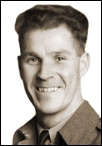 The reports make note of the famous Cousins baseball family of Beaverdell, enough boys, including pitcher Alymer Cousins (left), to field their own ball team. They were prominent in Okanagan area baseball from the 1930s into the mid 1950s.
The reports make note of the famous Cousins baseball family of Beaverdell, enough boys, including pitcher Alymer Cousins (left), to field their own ball team. They were prominent in Okanagan area baseball from the 1930s into the mid 1950s.
Alymer spent several seasons in the tough Vancouver Senior League. Alymer not Aylmer, as was frequently published, even on his Vancouver baseball card. A couple of misspellings have been corrected here.
![]() Baseball in Vancouver gets even more coverage with the discovery of more team photos of the Vancouver Firemen and the Vancouver Asahi.
Baseball in Vancouver gets even more coverage with the discovery of more team photos of the Vancouver Firemen and the Vancouver Asahi.

 Now posted are Firemen photos of the 1927, 1929 and 1930 teams. That's Cameron "Peggy" Duff from the 1927 club (far left) and Larry Holden (left) from the 1929 aggregation. Individual pictures have been extracted fro the 1927 and 1929 photo galleries.
Now posted are Firemen photos of the 1927, 1929 and 1930 teams. That's Cameron "Peggy" Duff from the 1927 club (far left) and Larry Holden (left) from the 1929 aggregation. Individual pictures have been extracted fro the 1927 and 1929 photo galleries.
Luckily we have been able to identify the players in two of the photos but need some help with IDs in the 1930 shot which includes players from the Seattle Firemen as well. I've included individual photos of the Vancouver players on the 1929 photo gallery to allow a comparison with the 1929 photos for ID purposes. It's a long shot, but have also written the Firemen's union in Vancouver in the hope that photo might still be displayed in one of the fire halls or in their archives. And, our Henry Ropertz is checking out the Vancouver papers in the hope they may have published the photo with names.
![]() There's even more on the Vancouver Asahis. For the 1921 season. we've posted a photo of the 1921 team which went on a tour of Japan (with a couple of non-Japanese imports) and of the Asahi Tigers. The main club played in the Vancouver Senior League while the Tigers competed in the Terminal circuit.
There's even more on the Vancouver Asahis. For the 1921 season. we've posted a photo of the 1921 team which went on a tour of Japan (with a couple of non-Japanese imports) and of the Asahi Tigers. The main club played in the Vancouver Senior League while the Tigers competed in the Terminal circuit.
Also newly posted are the team photos of the 1925 (we believe) Asahi and an improved picture of the 1926 team. The 1925 edition is, so far, without IDs.
02 February, 2017
![]() Linda Ward, where are you ? Your old email address no longer connects.
Linda Ward, where are you ? Your old email address no longer connects.
 Linda is the daughter of Harry Hayes (left) who pitched for Bassano of the Western Canada League in 1912. He was one of the top hurlers in the league with a 19-8 won-lost record.
Linda is the daughter of Harry Hayes (left) who pitched for Bassano of the Western Canada League in 1912. He was one of the top hurlers in the league with a 19-8 won-lost record.
Hayes, who also played under the name Hughes was a high school, college & semi-pro phenom (reports of a no-hitter, a total of 75 strikeouts in three high school games, a 32-6 season) who advanced as far as the Pacific Coast League with San Francisco. A few years back, Linda got in touch as part of her effort to discover more information on his grandfather. We can now help with that.
![]() Lot of interesting pieces added in the last few days as we clean up a to-do list.
Lot of interesting pieces added in the last few days as we clean up a to-do list.
Back to 1902 we've added a newspaper photo of the Northern League champion Winnipeg Maroons.
In the 1912 snapshot section there's the photo of Harry Hayes and there's Toots Bliss. (An earlier reference to Hayes had him as a left-hander, but he's clearly a righty.)
We're really pleased to slot in two photos of the 1915 Seattle Giants, courtesy of David Eskenazi. Individual pictures (Frank Juney, Pat Eastley, Harry "Hap" Morse, Tealey Raymond) have been extracted for our photo galleries.
The 1926-1927 rosters include more complete Courtenay and Alberni rosters.
I'm not certain if this 1930 team photo is of Woodfibre & Haney team members ((there are a few "other" uniforms).or perhaps just Woodfibre after playing Haney. The Woodfibre team was the club of Western Forest Products (there is a small W/F on the uniforms along the B.C. Pulp lettering.
And, there are a few games added to the 1951 Chinook League (Alberta) results.
![]() It's been 75 years since the Vancouver Asahi played its last game and the Canadian government began jailing Japanese-Canadians in internment camps in the BC Interior. But, the Asahi remain a topic of great interest with two recent books and a movie on the famous team. We are adding to our Asahi file with ten more team photos or composites.
It's been 75 years since the Vancouver Asahi played its last game and the Canadian government began jailing Japanese-Canadians in internment camps in the BC Interior. But, the Asahi remain a topic of great interest with two recent books and a movie on the famous team. We are adding to our Asahi file with ten more team photos or composites.
Now posted are images of the 1915 club, the 1919 International League champions, and the 1920 and 1929 editions. The Asahi took home the championship trophy of the Terminal League in 1930 and in 1933. In 1938 they exceeded all expectations winning the Burrard League and Commercial League titles before defeating Seattle for the Pacific Northwest championship.
The 1940 Vancouver Asahi club is now pictured, the next-to-last of the famous coast club, before the Canadian government began the internment of Japanese during the war. Individual photos appear in the 1940 BC Photo Gallery.
In the camps, however, the Japanese used baseball as one of the means to maintain community spirit and belonging. This photo from one of the camps, during the period 1940-1945, shows the Farmers' team. Unfortunately, no IDs are available. It's believed some members of the Asahi are in the group.
![]() Wait 'til you note when the following was published.
Wait 'til you note when the following was published.
NOTHING LIKE IT USED TO BE
Perhaps the most regrettable feature of the present day highly organized professional baseball leagues is the passing of those roaring home-town ball games of twenty years ago. Those were great old days when men and boys played the game for the fun they got out of it, or pride in the village team. Once in awhile we paid a player for the time he lost at his regular job, but as for salaries, there was nothing doing. Today, if you want a pitcher to pitch a game of ball he must be paid at least $25 for the job and all the rest of the team must have at least a day's wages for helping to beat the nine from another town. Do they play as loyally or as earnestly as they did in the days of the sizzlin' hot old ball game? They do not. But baseball like everything else today is commercialized. And it is not how much fun we can get out of it, but how much money can the players make. (Cumberland Islander, July 2, 1926)
![]() It's another one of those "Can you believe this?"
It's another one of those "Can you believe this?"
It's September third, 1915 in Peoria, Illinois. The Proctor Recreation Centres are up against Keifer's Colts in a semi-pro double-header. Proctor's 18-year-old Walter Breymeir goes the distance in the opener, a game called after 11-innings of scoreless ball. He kid gives up just three hits and fans six in the shutout.
He's back out on the mound for the second game as well. It goes 23 innings and Breymeir battles all the way with a six-hitter and punches out the game-winning hit in a 6-5 victory. He racks up 15 strikeouts. 34 innings in one day ! So far, we've found no record of Breymeir ever pitching again. The story was published in papers across the United States and repeated in Spalding's Official Base Ball Guide of 1916.
![]() At least a few noticed. This from the Saskatoon Phoenix of July 9, 1915.
At least a few noticed. This from the Saskatoon Phoenix of July 9, 1915.
COLOR LINE BARS MANY A FAST MAN
Several Negro Pitchers Have Set Up Real Records -- Donaldson Worth $50,000, Says McGraw
The color line drawn so tightly around major league baseball has barred from major league fields three of the greatest pitchers the game has produced.
One of the trio, John Donaldson, pitching semi-pro ball in Kansas City, recently pitched 30 innings without allowing a hit or a run -- a record without parallel.
"If Donaldson were a white man, or if the unwritten law of baseball didn't bar negroes from the major leagues, I would give $50,000 for him -- and think I was getting a bargain," said John McGraw of the Giants, after seeing Donaldson pitch several games in Cuba.
Donaldson, just before establishing his record of pitching 30 innings without being hit, struck out 25 men in a 12-inning game, an average of better than two strikeouts per inning.
Donaldson just now is twirling for the All Nationals, a Kansas City team composed of players of all nations and an outfit that baseball sharps claim is strong enough to give any major league club a nip and tuck battle.
Frank Wickware is another negro pitcher who would rank with the Walter Johnsons, Joe Woods and Clove Alexanders if he were a white man. Wickware performed some marvellous pitching feats in an around Schenectady, N.Y., and has since moved on to Chicago where he has become a sensation among the semi-pros.
Wickware has marvellous speed, a weird set of curves and wonderful control. And he has a truck that has made him feared among batters. He throws what seems to be a "bean ball" but his control is so perfect that he never yet has hit a batter on the head. But when the batters see the ball, propelled with mighty force, come for their heads, they jump away, and the ball, taking its proper and well-time curve, arches over the plate for a strike.
Wickware has compiled a wonderful strikeout average. He figured in about 30 games over a stretch of three years from 1912, and struck out something like 250 batsmen, an average of about 8 1/3 to a game. In one game he fanned 15 men. He has allowed on an average only five hits to a game for the last 20 games pitched and over a stretch of 15 games he allowed only 26 runs -- less than two runs to a game.
In Cuba there is a negro pitcher by the name of Mendez. He's known as the "The Black Matty" and his work has been almost as brilliant as that of "The Big Six" of the Giants. Mendez is only of medium height, but he has terrific power in his arm.
The Cuban negro has a canny brain, and he always has used it. He has mixed his fast ball with his slow one, has an assortment of beautiful curves and perfect control.
Pitching for the speedy Almendares team, he has established some amazing records. He he has done so without really trying. Like Mathewson, he never pitches airtight ball unless he has to. He conserves his strength. But when he needs to pitch hitless ball he does it. When he needs to strike out a man he usually succeeds. But he always works on the theory that he has eight men to aid him in his defensive work.
28 January, 2017
![]() Again, David Eskenazi, such a good friend of our site, has come to the rescue. We were seeking a good photo of Elwyn "Peggy" Barth (below far left) to go along with our crowning of the teenager as the Western Canada League batting champion of 1914. David has sent along several photos of Seattle teams and individuals from the early 1900s.
Again, David Eskenazi, such a good friend of our site, has come to the rescue. We were seeking a good photo of Elwyn "Peggy" Barth (below far left) to go along with our crowning of the teenager as the Western Canada League batting champion of 1914. David has sent along several photos of Seattle teams and individuals from the early 1900s.

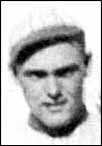 The Barth photo has sent us on a hunt to try and pick out Barth from photos at The Esplanade Arts and Heritage Centre in Medicine Hat. Pictures from the scrapbook of a former 'Hat player, Speed Martin, have found a home at the Esplanade, but so far, no IDs.
The Barth photo has sent us on a hunt to try and pick out Barth from photos at The Esplanade Arts and Heritage Centre in Medicine Hat. Pictures from the scrapbook of a former 'Hat player, Speed Martin, have found a home at the Esplanade, but so far, no IDs.
In 1914 Medicine Hat had two catchers -- Barth and Arthur Harry "Toots" Bliss. There is one photo with the two, at least both are in Medicine Hat uniforms and both have catcher's mitts. Thus, we assume one is Barth and the other is Bliss. But which is which? Are these two a match ?
We've pulled photos from two other team photos (teams for which Bliss played) and believe all three photos below might well be Bliss. Whaddya think? Wish the two other photos were of better quality.



 As luck would have it, the team photo in which had Barth also featured Harry "Hap" Morse, the player incorrectly declared as the 1914 batting champion because of an error in simple math. You wonder if they had any conversations about the batting championship or even if they figured out there was a mistake.
As luck would have it, the team photo in which had Barth also featured Harry "Hap" Morse, the player incorrectly declared as the 1914 batting champion because of an error in simple math. You wonder if they had any conversations about the batting championship or even if they figured out there was a mistake.
 In 1915 both were playing with the Seattle Giants of the Northwestern League. Also on that club were others who were associated with Western Canada baseball -- Al Bonner, Charles Brooks, Pat Eastley, Frank Juney, Jack Smith and Tealey Raymond (right).
In 1915 both were playing with the Seattle Giants of the Northwestern League. Also on that club were others who were associated with Western Canada baseball -- Al Bonner, Charles Brooks, Pat Eastley, Frank Juney, Jack Smith and Tealey Raymond (right).
We've also discovered that Barth, was not 18 but just 17 when he won the crown (that's been changed on the stats page). He had such a bright future ahead. Signed by the Brooklyn Dodgers and destined for Spring Training in 1916, he died in late 1915. Pneumonia.
![]() Old friend Jack Altman correctly points out the oversight in not noting the Major League accomplishments of Floyd Herman, one of the three players noted in the story below challenging for the 1921 batting championship. Herman, to be know as "Babe" Herman had a terrific 13-year career, mainly with the Dodgers. In 1930, Herman swatted .393/.455/ .678 with 48 doubles, 11 triples and 35 home runs. He knocked in 130 and added 18 stolen bases. He drew 66 walks and fanned just 56 times. For his career, Herman carried a .324 average. .
Old friend Jack Altman correctly points out the oversight in not noting the Major League accomplishments of Floyd Herman, one of the three players noted in the story below challenging for the 1921 batting championship. Herman, to be know as "Babe" Herman had a terrific 13-year career, mainly with the Dodgers. In 1930, Herman swatted .393/.455/ .678 with 48 doubles, 11 triples and 35 home runs. He knocked in 130 and added 18 stolen bases. He drew 66 walks and fanned just 56 times. For his career, Herman carried a .324 average. .
![]() Lots of bits and pieces added over the last couple of weeks (including some newspaper headlines to the item on the 1921 batting championship below).
Lots of bits and pieces added over the last couple of weeks (including some newspaper headlines to the item on the 1921 batting championship below).
Louis "Roxy" Walters (as distinguished from Albert "Roxy" Walters of later WCBL play) is added to the 1909 photo gallery. Others include, Ducky Holmes & Albert Isbell 1910, Jimmy Concannon (along with Barth & Morse) 1914, Roy Grover and Jess Buckles, 1914, Roy Bliss, 1921, Buddy Afremow, 1951, Larry Kowalishen in a 1974 photo gallery and an action shot in 1974.
We have a clearer photo of the 1912 Red Deer Eskimos, and an additional photo of Red Deer's opening game in 1912 thanks to the Red Deer and District Archives. More information has been added on names for the 1912 Edmonton team photo.
![]() There is a new photo gallery for the Southern Minnesota League, the 1959 season, along with the few final statistics we;ve been able to locate, and the 1959 rosters. The quality isn't very good, but we've posted a couple of team photos we found in our newspaper searches, the 1959 Austin Packers and the 1960 Mason City Braves. The Braves of that summer featured a couple of former Lloydminster Meridians, Don Kuodis and, at least briefly, David Moriarty.
There is a new photo gallery for the Southern Minnesota League, the 1959 season, along with the few final statistics we;ve been able to locate, and the 1959 rosters. The quality isn't very good, but we've posted a couple of team photos we found in our newspaper searches, the 1959 Austin Packers and the 1960 Mason City Braves. The Braves of that summer featured a couple of former Lloydminster Meridians, Don Kuodis and, at least briefly, David Moriarty.
17 January, 2017
![]() It has taken more than a hundred years, in most cases, but I think we finally have the correct batting champions for the 1907, 1911, 1912, 1914 and 1921 Western Canada League seasons.
It has taken more than a hundred years, in most cases, but I think we finally have the correct batting champions for the 1907, 1911, 1912, 1914 and 1921 Western Canada League seasons.
A critical second and third look at the early WCBL statistics has brought about a change in the awarding of champions, at least from our perspective.
This re-look came about as we began to put together summary pages for the Western Canada leagues (following the format of the present Basin League, Intercounty League, and Southern Minnesota League).
Our project included the early Western Canada League of 1907-1921 and the Western Canada loop of 1954-1963, each running ten years.
The central problem at the time was a lack of a standard as to who qualified for the title. Another, more obvious difficulty, was a lack of accuracy. For example, in 1914, Harry Morse of Regina was tabbed as the batting king with a .344 average, while shown with 136 hits in 453 at bats. Somebody neglected to check the math. That ratio actually produces a .300 average, not .344. In addition, Elwyn Barth, the 17-year-old Medicine Hat catcher, had a better average (.367) and played in 60.6% of his team's games. (On a chance the 136 hits listed might have been a typo for 156 hits, which would have produced the .344 average, we checked box scores to confirm that .300 is the correct result.) (In a sad side note, we learned that Barth, who moved up to Seattle in the Northwestern League in 1915, and was drafted by the Dodgers after that season, died in December, 1915, of pneumonia. Barth, just 18 years of age, had been playing winter ball in the Imperial Valley League when struck down with the illness.)
 While there were no firm rules back then guiding the granting of batting champions it appeared there was a custom that a player had to participate in 60% of his team's scheduled games to be eligible. (This finding comes from the old Macmillan BASEBALL ENCYCLOPEDIA). Thus, Barth played in 60.6% of his team's games (and 61.5% of the team's "scheduled" games - Medicine Hat, scheduled to play just 130 games ended up playing 132, possibly because of replays of a pair of tie games, both 7-7 scores, both against Saskatoon). The intent of the use of "scheduled" in that custom of the day remains foggy. Barth's title was noted in the Medicine Hat News of September 21, 1914 (above).
While there were no firm rules back then guiding the granting of batting champions it appeared there was a custom that a player had to participate in 60% of his team's scheduled games to be eligible. (This finding comes from the old Macmillan BASEBALL ENCYCLOPEDIA). Thus, Barth played in 60.6% of his team's games (and 61.5% of the team's "scheduled" games - Medicine Hat, scheduled to play just 130 games ended up playing 132, possibly because of replays of a pair of tie games, both 7-7 scores, both against Saskatoon). The intent of the use of "scheduled" in that custom of the day remains foggy. Barth's title was noted in the Medicine Hat News of September 21, 1914 (above).
Nonetheless, we've decided to go with the 60% custom to see where it takes us. For 1907 it comes up with Ralph Works, the league's champion pitcher, as the top hitter as well.
 In 1911, William "Obie" O'Brien (left), takes over the batting title from Jack Fournier (who finished atop most of the batting categories and went on to a 15-year career in the major leagues with the White Sox, Yankees, Cardinals, Brooklyn Dodgers and Boston Braves).
In 1911, William "Obie" O'Brien (left), takes over the batting title from Jack Fournier (who finished atop most of the batting categories and went on to a 15-year career in the major leagues with the White Sox, Yankees, Cardinals, Brooklyn Dodgers and Boston Braves).
For 1912, we've always had Archie Persons as the champion, but other publications have gone with Eugene "Chesty" Cox, who was 30 points back but played in more games. Both were veterans of minor league baseball. Persons, as a point of interest, had attended West Point and the University of Wisconsin. Cox had previous Western Canadian experience playing for Winnipeg, Lethbridge, Moose Jaw and Edmonton.

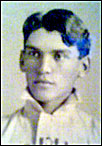
 The really interesting one is 1921. There was no unanimity here.
The really interesting one is 1921. There was no unanimity here.
The actual numbers showed Bill Speas (right), the Regina Senators' playing manager with a .350 average in 74 games. Frank Jude (far left) of the Saskatoon Quakers hit .335 playing 100 games and Floyd Herman (near left) of Edmonton Eskimos finished with a .330 average in 107 games.
 Jude got the nod from The Sporting News and The Encyclopedia of Minor League Baseball. The reference to "Happy Hunting Ground" in The Sporting News headline appears to have been a not-too-subtle connection to his Native American heritage.
Jude got the nod from The Sporting News and The Encyclopedia of Minor League Baseball. The reference to "Happy Hunting Ground" in The Sporting News headline appears to have been a not-too-subtle connection to his Native American heritage.
Speas, the Regina playing- manager, was crowned king by the Winnipeg Evening Tribute and the Manitoba Free Press while the Morning Leader out of Regina, the Edmonton Bulletin, Calgary's Morning Albertan and Spalding's Official Baseball Guide pegged Edmonton's Herman, "Slim" to some, and "Babe" to others, as the batting champion.

A new rule, in 1920, was supposed to clarify who was eligible for the batting title. The majors adopted a rule in which a batter had to appear in 100 games (154 game schedule), or 90 games (140 game schedule) to qualify for the batting title. In 1921, the Western Canada League had a 129 game schedule, but, partially because Regina and Moose Jaw dropped out, the most any team played was 115. So it seems reasonable to use the games played figure rather than the games scheduled figure in this case.
Although Regina dropped out of the circuit, Speas appeared in 64% of the games played by the most active team. The rule above, the 140 game schedule rule, works out to 64% of games player, so Speas, with some twists and turns, ought to have been considered for the batting crown. It's clear both Jude and Herman were qualifiers.
We still think Speas is the champ, but given the support for Jude and Herman by leading publications of the day we have to wimp out and list all three as possible champions !
Our compilation shows the following all-time records for the two eras of the Western Canada League.
WESTERN CANADA LEAGUE RECORDS 1907-1921
Games : 131, Les "Tug" Wilson, Saskatoon & Tom Herriott, Regina, 1914
Average : .392,William "Obie" O'Brien, Calgary, 1911
Runs : 111, Phil Apperson, Edmonton, 1921
Hits : 161, Nelson "Chicken" Hawks, Calgary, 1920
RBI : 80, Ernest Vache, Regina, 1920
Doubles : 30, Floyd "Babe" Herman, Edmonton, 1921
Triples : 19, Jack Smith, Regina, 1914 & Jack Fournier, Moose Jaw, 1911
Home Runs : 13, Brad Hollis, Calgary, 1913
Stolen Bases :
75, Pete "Hap" Morse, Edmonton, 1910
Games : 44, Jesse Buckles, Medicine Hat, 1914
ERA : 1.55, Albert Zweifel, Regina 1920
Wins : 26, Ferdy/Del Manning, Calgary, 1910 & Ralph Works, Medicine Hat, 1907
Losses : 19, Sheridan, Saskatoon, 1911
Pct : .875, 14-2,John Collins Winnipeg, 14-2, 1909
Innings : 331, Jesse Buckles, Medicine Hat, 1914
SO : 217, Ralph Works, Medicine Hat, 1907
BB : 129, Ralph Works, Medicine Hat, 1907 & Cyrus Pieh, Edmonton, 1911
WESTERN CANADA LEAGUE RECORDS 1954-1963
Games : 70, Gord Morgan, Saskatoon-Williston, 1959
Average : .409, Jerry Adair, Williston, 1958
Runs : 69, Calix Bauer, Edmonton, 1955
RBI : 68, Len Tucker, Saskatoon, 1957
Hits : 101, Tim Cullen, Calgary, 1963
2B : 26, Len Farrell, Edmonton, 1955
3B : 11, Bobby Cesar, Regina, 1957 & Don Buford, Lloydminster-NB, 1959
Home Runs : 19, Tim Cullen, Calgary, 1963
Stolen Bases : 33, Katsu Shitanashi, Edmonton, 1964
Games : 32, Gene Graves, Saskatoon, 1959
ERA : 1.40, Walt Peterson, Edmonton, 1963
Wins : 14, Norman Forsythe, Edmonton, 1959
Losses : 12, Pete Mauritsen, Lethbridge, 1964
Pct : 1.000, Sergio Fabre, Saskatoon (10-0), 1954
Innings : 148, Gene Graves, Saskatoon, 1959
SO : 149, Dale Zeigler, Edmonton, 1957
BB : 96, Mark Clark, Williston, 1959
![]() Rick Necker interrupted his search of Victoria baseball to help us come up with the real batting king of the 1914 Western Canada League. He's carried on to provide a framework of Victoria senior ball in 1934 which included hurler Tommy Musgrave one of the stars of the era. The expanded roster page includes a guy by the name of Bone playing for the Poodle Dog Cafe.
Rick Necker interrupted his search of Victoria baseball to help us come up with the real batting king of the 1914 Western Canada League. He's carried on to provide a framework of Victoria senior ball in 1934 which included hurler Tommy Musgrave one of the stars of the era. The expanded roster page includes a guy by the name of Bone playing for the Poodle Dog Cafe.

![]() Murray Gage-Cole a Canadian right-hander out of Washington State University was one of those talented young players who walked away from the pro game early, realizing that talent alone wasn't getting him ahead.
Murray Gage-Cole a Canadian right-hander out of Washington State University was one of those talented young players who walked away from the pro game early, realizing that talent alone wasn't getting him ahead.
No big break for Murray, just four seasons as a reliever, beginning in 1971 in the Phillies' system, in A-Ball with ERAs of 2.40 in 26 games, 2.25 in 55 games, 2.81 in 46 games and 1.71 in 43 games. After a couple of seasons pitching in the Mexican League, Gage-Cole returned to Canada to pitch for Team BC in the Canadian championships and various BC teams, the Calgary Cardinals and Red Deer Riggers into the late 1980s. He already had semi-pro experience in Yakima, WA, Trail, BC, and in the Basin League with Sturgis, SD. Murray was in touch last week and already has helped to fill in information in the 1970s and 1980s.
![]() We've got it ! The spelling that is, of Brent Macnab, former catcher in the old Big Four League of Alberta. Brent's son Mickey emailed to make the correction (we had an upper case "N" in Macnab). Mickey says dad is doing well, still golfing three times a week at age 86 ! We sent along a copy of the Edmonton Journal story of Brent's debut in 1950 with Edmonton - three hits in four appearances !
We've got it ! The spelling that is, of Brent Macnab, former catcher in the old Big Four League of Alberta. Brent's son Mickey emailed to make the correction (we had an upper case "N" in Macnab). Mickey says dad is doing well, still golfing three times a week at age 86 ! We sent along a copy of the Edmonton Journal story of Brent's debut in 1950 with Edmonton - three hits in four appearances !
![]() A few bits and pieces added, including a newer photo of the 1913 Moose Jaw Robin Hoods and another of the 1910 Edmonton Eskimos. We've discovered a photo of Team Canada of 1980 but without specific IDs. Individual player photos (a few just better versions) include Jack Day, Bob Wilson, Dean Couvier, Don Smith, Bill Carpenter, Clarence Rowlands and Bill Fortier.
A few bits and pieces added, including a newer photo of the 1913 Moose Jaw Robin Hoods and another of the 1910 Edmonton Eskimos. We've discovered a photo of Team Canada of 1980 but without specific IDs. Individual player photos (a few just better versions) include Jack Day, Bob Wilson, Dean Couvier, Don Smith, Bill Carpenter, Clarence Rowlands and Bill Fortier.
06 January, 2017
![]() Ace correspondent Rich Necker has survived the too much food and cheer of the holidays to give us a glance at 1937 baseball in the BC Interior. Striking is the number of familiar names which continue to turn up much later, even into the 1950s.
Ace correspondent Rich Necker has survived the too much food and cheer of the holidays to give us a glance at 1937 baseball in the BC Interior. Striking is the number of familiar names which continue to turn up much later, even into the 1950s.
Rich also has dug up a team of lemons from 1911. Formally, they were the Water Street Fruit Merchants of the Vancouver Commercial Baseball League but were known as the Lemons and, in fact, carried the name Lemons on their uniforms.


![]() From our "to-do" list we've followed the substantial updates of the Manitoba photo galleries with dozens of additions and updates of Alberta baseball in the 1970s, including the colour photos of members of the Red Deer Generals of 1974, such as Phil Urabe (far left) and Ken Nelson Jr. (near left) whose dad was a star player on Vancouver Island and then the prairies (mainly
From our "to-do" list we've followed the substantial updates of the Manitoba photo galleries with dozens of additions and updates of Alberta baseball in the 1970s, including the colour photos of members of the Red Deer Generals of 1974, such as Phil Urabe (far left) and Ken Nelson Jr. (near left) whose dad was a star player on Vancouver Island and then the prairies (mainly North Battleford) in the 1940s and 1950s. And there's this guy,Jim Bouton (right) , the former major leaguer who caused quite a stir with thepublication of his book Ball Four. Bouton made a couple of appearances in 1975 with Calgary Jimmes. In one, he tossed a two-hit shutout. Bouton was with Calgary while on holidays fromhis radio and TV gig in New York. The Alberta galleries of 1974, 1975, 1976, 1977 and 1978 all show major updates.
North Battleford) in the 1940s and 1950s. And there's this guy,Jim Bouton (right) , the former major leaguer who caused quite a stir with thepublication of his book Ball Four. Bouton made a couple of appearances in 1975 with Calgary Jimmes. In one, he tossed a two-hit shutout. Bouton was with Calgary while on holidays fromhis radio and TV gig in New York. The Alberta galleries of 1974, 1975, 1976, 1977 and 1978 all show major updates.
![]() There are a few updates to the Manitoba galleries of 1968, 1975 and 1976. And, we've expanded the coverage of the 1976 Kamloops Invitational Tournament with lots of new details and a few photos, too, including future major leaguer Wally Backman, then a 16-year-old, playing for an entry from Oregon.
There are a few updates to the Manitoba galleries of 1968, 1975 and 1976. And, we've expanded the coverage of the 1976 Kamloops Invitational Tournament with lots of new details and a few photos, too, including future major leaguer Wally Backman, then a 16-year-old, playing for an entry from Oregon.
![]() Colleague Alain Usereau continues his search for all the Canadian kids who played in the Expos system. Two, in particular, have been elusive. Russ McKee and Murray James. McKee, an outfielder, played just one season, 1971, for Watertown of the Northern League. When he signed with the Expos he was from Saanich, BC. James, a right-handed pitcher, played just one summer with the Expos club in the Gulf Coast League. Both later played semi-pro ball in Western Canada.
Colleague Alain Usereau continues his search for all the Canadian kids who played in the Expos system. Two, in particular, have been elusive. Russ McKee and Murray James. McKee, an outfielder, played just one season, 1971, for Watertown of the Northern League. When he signed with the Expos he was from Saanich, BC. James, a right-handed pitcher, played just one summer with the Expos club in the Gulf Coast League. Both later played semi-pro ball in Western Canada.
![]() A note from former Vulcan (1961-1962) hurler Steve Cottrell prompted me to look a little further for information on Bill Cundiff, who seems to have vanished from baseball after a sensational 1963 summer in the Manitoba Senior League.
A note from former Vulcan (1961-1962) hurler Steve Cottrell prompted me to look a little further for information on Bill Cundiff, who seems to have vanished from baseball after a sensational 1963 summer in the Manitoba Senior League.
Steve found a Bill Cundiff pitching in a city league in El Paso, Texas, in 1965. A subsequent search found quite a remarkable season. We have discovered that Cundiff was drafted into the US military in 1964, but with no information where he may have been posted (there is no listing of a Bill Cundiff as a casualty in Vietnam).
The 1965 Cundiff had a lights-out summer pitching for the El Paso 40-60 Club Rookies and, then, like the Manitoba Cundiff, seems to have just disappeared.
While it's pretty certain there are games missing from this list, here's what we have so far on Bill Cundiff in El Paso.
March 15 - Cundiff tosses a two-hitter, fans ten, no walks in a 10-0 shutout.
March ?? - Fans ten.
March 30 - 21 strikeouts in a 12-1 victory. After three games, he has 41 strikeouts in 19 innings.
April 04 - Six-hitter, 11 strikeouts.
April 13 - No-hitter, one walk away from a perfect game. 15 Ks, 8-0 shutout. In 33 innings, 67 Ks.
April 28 - One-hitter with 14 Ks, 19-1 victory.
May 17 - 23 strikeouts. In 48 innings, 104 strikeouts.
May 27 - Three-hitter, 14 Ks, 4-0 shutout.
June 17 - 21 Ks.
June 30 - One-hitter, 15 Ks, 9-1 win.
July 08 - Relief appearance, no details.
July 26 - Five-hitter, 19 Ks.
August 26 - Three-hitter, 12 Ks.
August 26 - Relief, no details.
From what's been published, or at least what we've been able to find, Cundiff racked up an 11-0 record with 185 strikeouts in just 89 innings. While no figures were available for earned runs, his run-average was a tidy 1.62. In 1963, the Manitoba Bill Cundiff whiffed 170 in just 106 innings. It's still a league record.
![]() So good to hear from Jim Lester. So sorry he's having such a tough time, and now in a facility in Carthage, just outside his hometown Peoria, Illinois. He's had very limited mobility because of back problems. But he's managed to keep in touch with many of his old teammates and friends. John Vaselenak, one of the Granum/Lethbridge stars of the 1950s, even made the trip down for a visit.
So good to hear from Jim Lester. So sorry he's having such a tough time, and now in a facility in Carthage, just outside his hometown Peoria, Illinois. He's had very limited mobility because of back problems. But he's managed to keep in touch with many of his old teammates and friends. John Vaselenak, one of the Granum/Lethbridge stars of the 1950s, even made the trip down for a visit.
![]() Fingers crossed. The search function appears to be back to normal. If you noticed anything weird, please let me know.
Fingers crossed. The search function appears to be back to normal. If you noticed anything weird, please let me know. ![]()
27 December, 2016

![]() There was no hint of the success William Henry "Bill" Cundiff would have in the 1963 season with the St. Lazare Athletics of the Manitoba Senior Baseball League.
There was no hint of the success William Henry "Bill" Cundiff would have in the 1963 season with the St. Lazare Athletics of the Manitoba Senior Baseball League.
Cundiff, a six-foot, 165 pound left-hander, out of Springfield, IL, had an extremely disappointing 1961 rookie season in pro ball going 0-8, 8.27 with three teams in the St. Louis Cardinals farm system. The following season, at age 21, was a baby step better, with five wins, but 11 losses with a 4.69 ERA and 137 strikeouts in 121 innings.
He began 1963 with Winnipeg Goldeyes of the Northern League but was gone after just two games. Luckily for St. Lazare, he suited up with the Athletics and proceeded to dazzle the loop as the top hurler winning nine games in 13 decisions and racking up 170 strikeouts in just 106 innings pitched. He yielded just 47 hits.
And, Cundiff's trail ends right there. There is no indication that he gave pro ball another shot or if he continued tossing semi-pro ball.
We've added 1963 rosters and statistics.

![]() Manitoba photo galleries - from 1961 to 1977 - have been expanded (several dozen new photos in all), with the 1965 and 1968 versions showing the most additional material, including the colour photo of the late Barry Moffatt, a hockey and baseball star in Manitoba. An earlier "News" item noted the tragedy.
Manitoba photo galleries - from 1961 to 1977 - have been expanded (several dozen new photos in all), with the 1965 and 1968 versions showing the most additional material, including the colour photo of the late Barry Moffatt, a hockey and baseball star in Manitoba. An earlier "News" item noted the tragedy.
Outfielder Barry Moffatt of the Riverside Canucks had just finished one of the most successful seasons in Manitoba senior baseball history. In the summer of 1969 the all-star in the outfield got at least one hit in every game he played, 30 in all, running away with the batting championship with a .481 average, nearly 70 points higher than the runner-up. Moffatt, who had had been playing senior ball in Manitoba since 1955 when he joined Souris as a 16-year-old, led the Canucks to the 1969 pennant.
Of course, Moffatt was also a hockey star. Four months after the end of the 1969 baseball season, playing for the Souris Elks in a Southwest Hockey League game he was checked into the boards and fell to the ice, unconscious. There was less than two minutes to play. Moffatt never regained consciousness. He had suffered a fractured skull. Moffatt had worn a helmet, a football helmet, a couple of years previous to protect a broken jaw, an injury suffered in another hockey game. But, he had discarded the protection once his jaw had healed. He was just 30
![]() Still with Manitoba ball, we have added game reports for the 1968 playoffs of the Manitoba Senior League as Riverside Canucks used late inning heroics to down Souris for the title.
Still with Manitoba ball, we have added game reports for the 1968 playoffs of the Manitoba Senior League as Riverside Canucks used late inning heroics to down Souris for the title.
The 1964 Manitoba Game Reports has been expanded, and the 1964 Manitoba Snapshot page has been re-done and has some additions.
![]() Elsewhere, we've made additions to the 1950 Alberta game reports with a bit of news on Big Four and Medicine Hat & District baseball.
Elsewhere, we've made additions to the 1950 Alberta game reports with a bit of news on Big Four and Medicine Hat & District baseball.
![]() Old favourite Dodger Lewis keeps popping up. We found a few stories from the 1921 season when the teenager was beginning his transition to a mound career. In what are believed to be his first four games with Hanna, Alberta, Lewis racked up strikeout totals of 17, 18, 17, and 19.
Old favourite Dodger Lewis keeps popping up. We found a few stories from the 1921 season when the teenager was beginning his transition to a mound career. In what are believed to be his first four games with Hanna, Alberta, Lewis racked up strikeout totals of 17, 18, 17, and 19.
![]() A heads-up on use of the search feature. For reasons still being investigated the search function is not showing some stuff that's actually on the site. We are hoping this will be resolved early in the New Year.
A heads-up on use of the search feature. For reasons still being investigated the search function is not showing some stuff that's actually on the site. We are hoping this will be resolved early in the New Year.
13 December, 2016

![]() All of a sudden it seems, it's nearly Christmas !
All of a sudden it seems, it's nearly Christmas !
Best wishes to all for family, friends, good food, good cheer over the holiday season and throughout the New Year.
2017 ? I'm still getting used to the switch to 2,000 !
![]() We've filled in a little more on early Manitoba baseball with the posting of information on 1914 leagues in Winnipeg, Brandon and Western Manitoba. Rich Necker has added in rosters and a team photo (from the Mercantile League).
We've filled in a little more on early Manitoba baseball with the posting of information on 1914 leagues in Winnipeg, Brandon and Western Manitoba. Rich Necker has added in rosters and a team photo (from the Mercantile League).
The coverage was sparse given the attention paid to Winnipeg's Maroons of the professional Northern League.
![]() Gotta love the work of correspondent Henry "Red Eye" Ropertz. I wonder what might be the result if I specifically asked for more detail ;-) !
Gotta love the work of correspondent Henry "Red Eye" Ropertz. I wonder what might be the result if I specifically asked for more detail ;-) !
Red Eye was determined to get the facts on three major barnstorming junkets of the 1930s -- the American League All-Stars tour of Japan in 1934, the All-Stars tour in Western Canada in 1934 and the Dai Nippon Baseball Club (soon to be the Tokyo Giants) tour of Western Canada in 1935. The package is in ! It's about and inch and a half thick and I'll dig in over the holidays.
13 December, 2016
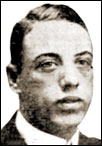
![]() A little more Frank Juney before we leave 1919.
A little more Frank Juney before we leave 1919.
We've discovered one more team which employed the pitcher-in-training, the Calgary Great War Veterans. That makes seven teams for Juney in three months of 1919, Moose Jaw, Calgary, Barons, Nick Williams' All-Stars, Oyen, Burdett, and Maple Creek. We now list 27 games as a pitcher, 23 starts, 23 complete games, 20-4. The information below and on the Snapshot page has been changed to match the new figures.
![]() The updated Alberta game reports include a few new entries as we stumbled into details of more contests, including the kickoff of the Calgary Senior League in 1919 before a crowd of 8,000 ! Remember, this is 1919. As usual, the rosters have been updated to include several dozen additional players.
The updated Alberta game reports include a few new entries as we stumbled into details of more contests, including the kickoff of the Calgary Senior League in 1919 before a crowd of 8,000 ! Remember, this is 1919. As usual, the rosters have been updated to include several dozen additional players.
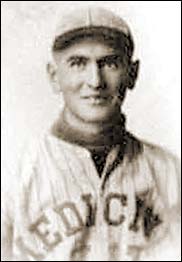
![]() Statistics have been added for the 1919 Calgary City League and the Medicine Hat Senior League.
Statistics have been added for the 1919 Calgary City League and the Medicine Hat Senior League.
Mel "Speedy" Wilson (left) of the Medicine Hat Monarchs was a major factor in 'Hat ball. The talented shortstop finished third in the batting race, at .402, and led the loop in hits, runs, total bases and triples.
 A. (no first name yet unearthed) Trout (right) also of the Monarchs was the king of the hill with a 10-1 record. He led the circuit in just about every pitching category.
A. (no first name yet unearthed) Trout (right) also of the Monarchs was the king of the hill with a 10-1 record. He led the circuit in just about every pitching category.
We did track down some stats for the Edmonton City League, but they are so lacking in detail and accuracy that we've left them on the shelf for now.
![]() Of course, we have lots of new pictures in the Photo Gallery from the rosters of the Calgary Hustlers and Medicine Hat Monarchs. Much thanks to the Esplanade Arts & Heritage Centre and the Glenbow Archives.
Of course, we have lots of new pictures in the Photo Gallery from the rosters of the Calgary Hustlers and Medicine Hat Monarchs. Much thanks to the Esplanade Arts & Heritage Centre and the Glenbow Archives.
![]() Team photos? Well, yes ! There are two pictures of the 1919-1920 Medicine Hat Monarchs and a newspaper quality version of the 1919 Nick Williams' All-Stars.
Team photos? Well, yes ! There are two pictures of the 1919-1920 Medicine Hat Monarchs and a newspaper quality version of the 1919 Nick Williams' All-Stars.

![]() Kent Morgan sends along some sad news from Manitoba. Bob Kabel, long-time Dauphin Redbirds' baseball star and one-time hockey NHLer passed away November 12th at the age of 82. Kabel played from the early 1950s to the early 1970s in both sports. He climbed the pro hockey ladder to play with the New York Rangers in 1959-60 for 44 games and a few games the following season. Kabel was among the original group of inductees into the Manitoba
Kent Morgan sends along some sad news from Manitoba. Bob Kabel, long-time Dauphin Redbirds' baseball star and one-time hockey NHLer passed away November 12th at the age of 82. Kabel played from the early 1950s to the early 1970s in both sports. He climbed the pro hockey ladder to play with the New York Rangers in 1959-60 for 44 games and a few games the following season. Kabel was among the original group of inductees into the Manitoba  Baseball Hall of Fame in 1997.
Baseball Hall of Fame in 1997.
Bruce Hudson, who was inducted as a player in 2003, died October 8th. Bruce played for the St. Boniface Native Sons and the Rosedales organization that are both in the Hall of Fame. Bruce also was a two-time Manitoba men's curling champion.
Flin Flon native George Konik, a hockey star who was an excellent catcher, led the Polar League in batting in 1959 with a .537 average. He played for Ross' Stylers. He died in Eagan, Minnesota on October 21st.
![]() Some folks need some help. If you can provide any assistance, please let me know
Some folks need some help. If you can provide any assistance, please let me know ![]()
![]() It's a long shot, but maybe there's someone with more photos ! Richard dePencier is on the lookout for pictures of his step-dad Perry Jeffries who played for the Calgary Jimmies, in 1976. Perry has passed away but Richard is hoping to put together an album for the family.
It's a long shot, but maybe there's someone with more photos ! Richard dePencier is on the lookout for pictures of his step-dad Perry Jeffries who played for the Calgary Jimmies, in 1976. Perry has passed away but Richard is hoping to put together an album for the family.
![]() Danielle Nakhleh is searching for information on her grand grandfather, Charlie Stevenson, who played in the old Vancouver Senior League in the 1920s and 1930s. She is particularly interested in the uniforms of the Vancouver Firemen of that era.
Danielle Nakhleh is searching for information on her grand grandfather, Charlie Stevenson, who played in the old Vancouver Senior League in the 1920s and 1930s. She is particularly interested in the uniforms of the Vancouver Firemen of that era.
![]() Michael Stahl of New York City has been in touch searching for information on Negro Leaguers playing in Canada. Michael is the Features Editor of a very interesting site - Narratively.
Michael Stahl of New York City has been in touch searching for information on Negro Leaguers playing in Canada. Michael is the Features Editor of a very interesting site - Narratively.
![]() Denmark Vea is checking for photos of George Fowlkes, a pitcher out of Cal Poly who played in Alberta in the early 1960s with Leduc and Edmonton.
Denmark Vea is checking for photos of George Fowlkes, a pitcher out of Cal Poly who played in Alberta in the early 1960s with Leduc and Edmonton.
![]() Jeanette McFarlane is chasing information on small town baseball in Ontario, "Looking for Headwaters communities. Guelph to Caledon, Shelburne to Orangeville to Creemore and all the little places in between."
Jeanette McFarlane is chasing information on small town baseball in Ontario, "Looking for Headwaters communities. Guelph to Caledon, Shelburne to Orangeville to Creemore and all the little places in between."
![]() Bob Isbister is on the hunt for photos and info on his brother-in-law Zenon Markowsky who played for Prince Albert, Kindersley, North Battleford, Saskatoon and Yorkton in the 1960s and 1970s.
Bob Isbister is on the hunt for photos and info on his brother-in-law Zenon Markowsky who played for Prince Albert, Kindersley, North Battleford, Saskatoon and Yorkton in the 1960s and 1970s.

![]() A book for Christmas?
A book for Christmas?
Sherman Jenkins has Ted Strong Jr.: The Untold Story of an Original Harlem Globetrotter and Negro Leagues All-Star now on the bookshelves and, of course, available through Amazon or www.tedstrongjr.com.
Strong was quite the athlete, a star both on the diamond and the court, playing baseball in the Negro Leagues and an original Harlem Globetrottter.
They picked him (Jackie Robinson) for his intelligence, but we had a lot of ballplayers we thought were better ballplayers. We always thought that Ted Strong was about the most ideal ballplayer. He had all the tools… (he was) a switch hitter, and could play just about anywhere. Anywhere you put Ted, Ted was at home – first base, shortstop, outfield. From the outfield he could really throw; you couldn’t take a turn from first to third on him. ( Negro League player Othello Renfroe, from the book “Voices from the Great Black Baseball Leagues,” by John Holway)
Coincidently, just after receiving a note from Sherman, our ace correspondent Rich Necker sent along an advertisement which appeared in the Vernon, BC, newspaper in January, 1937 (this is a heavily edited version, cleaning up the background, photos and lettering to make it easier to read). Yes, that's Strong in the upper left.
Note the admission prices - 50-cents, 10-cents for children !
The appeal of the Globetrotters is further emphasized in noting that the club got local businesses to pay for the cost of the ad !
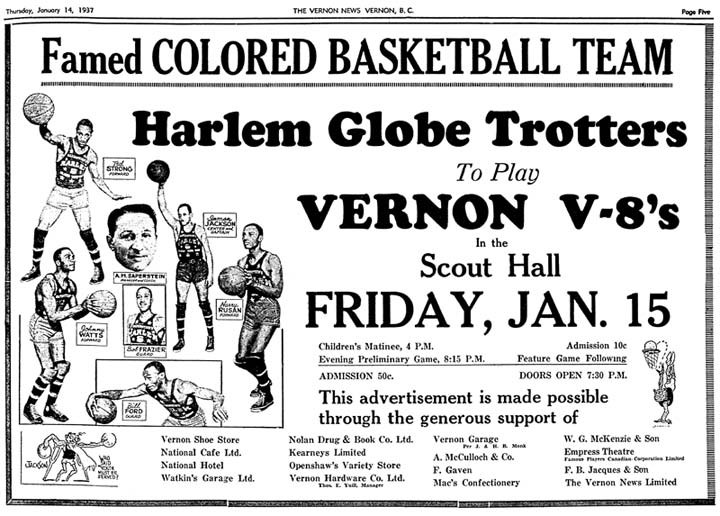
![]() Advertisement in the Manitoba Free Press, May 2, 1919 :
Advertisement in the Manitoba Free Press, May 2, 1919 :
WANTED AT ONCE, FIRST CLASS
barber, baseball player preferred. Wages:
$20; 60 over, $25. Phone 139 or write Box
42, E. Miller, Russell, Man.
Item in the Medicine Hat News, October 2, 1919, after the Medicine Hat Monarchs had upset the Calgary Hillhurst Hustlers for the Alberta baseball championship. Hmmm - rubbing salt in the wound?

08 December, 2016
![]() A couple of weeks back, Lou DeRosa, former hurler for Trail and other teams in the Kootenay, BC, region phoned to enquire whether I would be interested in some baseball material he had acquired -- minutes of the meetings of the Edmonton Old Timers Baseball Association from the late 1960s and early 1970s.
A couple of weeks back, Lou DeRosa, former hurler for Trail and other teams in the Kootenay, BC, region phoned to enquire whether I would be interested in some baseball material he had acquired -- minutes of the meetings of the Edmonton Old Timers Baseball Association from the late 1960s and early 1970s.
Interested I was, but little did I know the gems these documents would contain.
Initially, the minutes proved very helpful in tracking down correct spellings and first names of former Edmonton and area players (among them, Cap Spiessman - yes, two "esses", Paul "Doc" Duteau, Barney Marskell, Ernie Marskell, Reg, Ava and Bobby Cruthers -- not Carruthers -- Jack Starky -- not Starkey, Joe "Red" Tulloch -- not Tullock -- Roy Forman, Klingspoon, East Edsel, Howard Deeton, Athol "Pep" Young, Alva Sibbett -- not Sibbetts -- and on and on and on. In addition, the notes contained complete rosters for several seasons and background information on dozens of individual players. I was able to make changes to several hundred entries on our roster sheets.
The detailed information in the minutes enabled the consolidation of numerous individual entries, such as Mack, Mack B., Mack Lefty, Mack Blair into one single entry.
And, among the tidbits in one of the marvelous annual reports written by John Ducey (Edmonton's Mr. Baseball) was a note about a Manitoba pitcher, Joe Johnson, who must have set a record hurling four shutouts in the same day. The report of October, 1967, mentioned that the achievement had been featured in "Ripley's Believe Or Not".
 Intrigued, I set about to try and confirm the story. And, from a report in the Manitoba Free Press, Winnipeg, July 08, 1921, there it is. The event occurred at the Arden, Manitoba, Sports Day.
Intrigued, I set about to try and confirm the story. And, from a report in the Manitoba Free Press, Winnipeg, July 08, 1921, there it is. The event occurred at the Arden, Manitoba, Sports Day.
Johnson (no first name given in the newspaper story), pitching for Plumas, beat Wellwood 2-0 in the opener. In the second round, Bert McDougall belted a grand slam homer to give Plumas a 4-0 win over Maple. Johnson fired a third shutout in a 3-0 win over Arden in a semi-final and then was back on the hill for the final, a 2-0 victory over Eden in a game which went just three innings, ending because of darkness. Alfred, Johnson's battery mate, slugged a homer, the longest seen at the field all season. Thus, while the last game is tainted (just three innings), it's still a remarkable achievement.
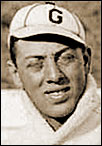 In tracking down the "Four Shutouts in a Day" story, I came across news of another possible mind-blowing, record-setting performance. There was mention of a pitcher who tossed back-to-back shutouts in a tournament double-header striking out a total of 42 batters, 24 in one game, 18 in the other.
In tracking down the "Four Shutouts in a Day" story, I came across news of another possible mind-blowing, record-setting performance. There was mention of a pitcher who tossed back-to-back shutouts in a tournament double-header striking out a total of 42 batters, 24 in one game, 18 in the other.
That led me to baseball maverick Frank Juney.
And yes, indeed, Juney tossed back-to-back shutouts with 42 Ks. AND - the first shutout was a no-hitter ! This was at the Maple Creek, Saskatchewan, Veterans Day tournament, August 15, 1919. Juney had earlier tossed a pair of one-hitters for Barons. Thanks to Philip Pype, Archivist for Medicine Hat's Esplanade Arts & Heritage Centre for digging out the clipping from the Maple Creek paper. In 1929, Nick Williams, then manager of the San Francisco Seals, confirmed the story in an item printed in the Woodland, California, Daily Democrat. Williams was his catcher that day in 1919.
This stunning effort is even more remarkable given that Juney was just beginning to hone his craft as a pitcher. He had begun the season as a third baseman for the Moose Jaw Robin Hoods of the Western Canada League. Released after ten games (he hit just .147), he linked up with mentor and former manager Nick Williams who was fielding a team for Barons, Alberta. Juney (real name Guigni/Giugni) has been a star player at St. Mary's College in California but had limited success as a third baseman in pro ball (although he did hit .291 in 32 games with Seattle in 1916). Obviously, Williams had a star student in Juney. He was considered the top hurler in Alberta in 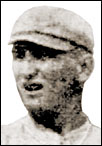 1919 pitching for at least eight different teams covering 28 games. He compiled at least 20 wins, losing but four. In 23 starts, he completed every one. He starred as both a pitcher and a hitter, for the most part batting in the number three slot. Juney turned out to be such a top twirler that Barons dumped pitcher Luke Glaven (right) who had also begun the year at Moose Jaw. Glaven (as Glavenich) had had a cup of coffee in the majors with Cleveland.
1919 pitching for at least eight different teams covering 28 games. He compiled at least 20 wins, losing but four. In 23 starts, he completed every one. He starred as both a pitcher and a hitter, for the most part batting in the number three slot. Juney turned out to be such a top twirler that Barons dumped pitcher Luke Glaven (right) who had also begun the year at Moose Jaw. Glaven (as Glavenich) had had a cup of coffee in the majors with Cleveland.
Earlier in the summer, pitching for yet another team, Burdett, Juney beat Taber, prompting one of the best reviews of the 1919 season
Tufteland occupied the box for Taber and deserves credit for the splendid game pitched by him. The only fly in the ointment was this man Juney -- we think it was ungracious of Burdette at a time when we are suffering from a strike and menaced with a crop failure to flaunt before us a Millionaire pitcher from Barons. It is such unjudicious display of wealth that fosters Bolshevism. (Taber correspondent to the Lethbridge Herald, July 3, 1919)
This would be just the beginning of the Juney story. He went on to pitch in mainly independent ball until the mid 1930s becoming a legend in Montana. Among other things :
* February, 1913 - in a move described as a severe blow to the St. Mary's college baseball team, Guigni/Giugni announced he was leaving school to join Nick Williams' Portland team in the Northwestern League.
* September 1915 - Juney was hailed as the most dangerous hitter on the Seattle Giants Northwestern League team.
* March, 1916 - Guigni/Giugni, the Seattle third sacker was a holdout and asked for his release.
* March, 1920 - Juney threw five scoreless innings against the Chicago Cubs in a Spring Training exhibition.
* June, 1920 - Juney jumped the Portland club to play for an independent team. After one game, he returned to the Beavers.
* July, 1920 - Juney walked away from the Portland Beavers for the second time, he was then banned from organized ball.
* July 1920 - Juney signed with the Madera Coyotes of the Northern San Joaquin Valley League for a salary in excess of $1,000 a month, considered to be the highest rate for a game a week in any minor league organization. (This was in the era when Ty Cobb had the top major league salary of $20,000 annually). Fans in Salinas were upset with Juney for jumping their club for Madera.
* November, 1920 - Juney vs Ty Cobb. After facing Juney three times (two strikeouts & a double) in an exhibition game, with two strikes on him, Cobb walked away from the plate and declined to continue, apparently not keen to face Juney's "doctored" pitches.
* February, 1921 - A report from San Francisco said Juney might buy his release from Portland for $500. Baseball supporters in Salinas appeared to be willing to pay to enable Juney to play with their team.
* October, 1921 - Juney is reported to have set a pitching record by recording 24 of the 27 outs. Pitching for Burbanks, he struck out twenty-one, had two assists and one putout.
* December, 1921 - Baseball commissioner Judge Landis denied an application by Juney for reinstatement in organized baseball. Juney jumped the Portland team in 1920 to play with independent teams.
* May, 1924 - Frank Juney, Willows pitcher, was suspended for ten days on account of his attack on an umpire.
* June, 1925 - Frank Juney and Whit McGill of the Willows baseball team were in jail in Sacramento charged as proprietors of a local poolroom, with having illicit liquor in their possession and resisting the attempts of agents of the federal prohibition office to arrest them.
* August 1925 - Juney was accused of various pitching irregularities, "rosin, emery, creosote, nicked balls and other incidents."
* July 1927 - Juney was suspended indefinitely from the Willows team "for playing in another organized league without permission." Juney was reported to be a great drawing card in the loop.
* August, 1964 - Bud Emanual, a former player in the Montana Mines League, recalled the days of Frank Juney and vigorous allegations about doctoring the baseball. "It was not unusual to have 60 to 70 baseballs used in a game when Juney was on the mound. Although the umpires never found Juney guilty they used to accede time after time to the opposition's request for a new ball ... Juney needed only one thing to make his sailor, or glider-like delivery effective. Catcher Gil White would throw a bouncer ball to second baseman Charles "Chaw" Callan for relay to the pitcher's box. That one bounce on the granite-like surfaces of the park here, and in Anaconda, did the trick for him ...Try and recall the many pitching "hotshots" of the old Mines league. Anyone's list may overlook a few of the star hurlers, but everyone's will contain Juney's name. (Montana Butte Standard, May 17, 1936)
![]() Our 1919 coverage extends, of course, to Southern Alberta game reports, tournament stories, rosters, and a snapshot page which includes the photos of Juney, Glaven and another 1919 pitching performer, Emery Webb.
Our 1919 coverage extends, of course, to Southern Alberta game reports, tournament stories, rosters, and a snapshot page which includes the photos of Juney, Glaven and another 1919 pitching performer, Emery Webb.
![]() Did I mention these additions ? Game reports for the 1930 Winnipeg Senior League, the 1955 Greater Winnipeg Senior League, 1954 and 1955 Ontario Intercounty League game reports and 1968 Manitoba snapshots. Frankly, I lost the list I keep of updates and may be missing a couple. Anyway, lots of new stuff. And always - kudos to Rich Necker for his exceptional work in research and presentation !
Did I mention these additions ? Game reports for the 1930 Winnipeg Senior League, the 1955 Greater Winnipeg Senior League, 1954 and 1955 Ontario Intercounty League game reports and 1968 Manitoba snapshots. Frankly, I lost the list I keep of updates and may be missing a couple. Anyway, lots of new stuff. And always - kudos to Rich Necker for his exceptional work in research and presentation !

![]() Clifford Gordon "Stiffy" Lewis. We now know it was Stiffy's granddaughter who sent along the information about his real name. Lianne mentioned the family had few photos of her grandfather so I managed to find a couple of fairly good pictures to send along. Lianne said her mother, now 92, was thrilled. Nice to be able to help out !
Clifford Gordon "Stiffy" Lewis. We now know it was Stiffy's granddaughter who sent along the information about his real name. Lianne mentioned the family had few photos of her grandfather so I managed to find a couple of fairly good pictures to send along. Lianne said her mother, now 92, was thrilled. Nice to be able to help out !
![]() Among the items Archivist Philip Pype has kindly send along is a team photo of the 1923 Southern Alberta champion Medicine Hat club. Thank you ! More to come.
Among the items Archivist Philip Pype has kindly send along is a team photo of the 1923 Southern Alberta champion Medicine Hat club. Thank you ! More to come.
22 November, 2016
![]() One of the best sources for prairie baseball photos is the Local History section of the Saskatoon Public Library. A few months back we accepted a challenge from the library to identify players in some photos from the 1940s. We're happy to respond to a photo from the 1942 Saskatoon Exhibition Tournament. Initially, it was pretty easy to ID a few of the players, especially the Bentley brothers. Now, we've filled out the list, confirmed by a caption in the Saskatoon Star-Phoenix.
One of the best sources for prairie baseball photos is the Local History section of the Saskatoon Public Library. A few months back we accepted a challenge from the library to identify players in some photos from the 1940s. We're happy to respond to a photo from the 1942 Saskatoon Exhibition Tournament. Initially, it was pretty easy to ID a few of the players, especially the Bentley brothers. Now, we've filled out the list, confirmed by a caption in the Saskatoon Star-Phoenix.
It's 1942 tournament champion Delisle. From the team photo we've extracted some individual pictures for the 1942 Saskatchewan Photo Gallery.
![]() Four new team photos adorn coverage of Minnesota baseball :
Four new team photos adorn coverage of Minnesota baseball :
1945 Alert Lea Packers
1949 Austin Packers
1950 Austin Packers
1954 Stillwater Loggers
21 November, 2016
![]() It's Photo Day !
It's Photo Day !
From more than 100 years ago, there's a team photo of the 1907 Kamloops team. Not unusual for the period, just nine players.
From 1919, there's the Kamloops Vets, the champions of the Kamloops City League. No players yet identified.
Also, from the 1919 season, we've identified another couple of players in a photo of a Vancouver all-star team.
On the 1921 Alberta Photo Gallery, we've added Cap Spiessman (of particular interest as we try to ID at least three Spiesman/Spiessman who played from 1900s to the 1940s).
There's a better photo now posted of the 1922 team from Brouse, BC (just outside Nakusp). Maybe they were a really powerful team, or maybe there's a player missing as the photo includes just eight guys.
Into the 1930s, we've added the 1930 Edmonton Young Liberals and the 1937 Edmonton Army & Navy Cardinals (with names too!).
The Edmonton Arrows were the champions of the Edmonton Senior League in 1942. Players are identified and a couple of individual pics have been posted in the Photo Gallery.
![]() No reason to doubt the information - an unsigned email simply stating, "Dodger Lewis' brother "Stiffy" Lewis' name is Clifford Gordon Lewis". Neat.
No reason to doubt the information - an unsigned email simply stating, "Dodger Lewis' brother "Stiffy" Lewis' name is Clifford Gordon Lewis". Neat.
19 November, 2016
![]() One more piece of the baseball puzzle has been added to our collection of material on "baseball in BC". From the sleuthing of Rich Necker we've added game reports and rosters (along with the previously noted, statistics) for Vancouver Island teams in 1932. We've even added to the pictures in the Photo Gallery.
One more piece of the baseball puzzle has been added to our collection of material on "baseball in BC". From the sleuthing of Rich Necker we've added game reports and rosters (along with the previously noted, statistics) for Vancouver Island teams in 1932. We've even added to the pictures in the Photo Gallery.
![]() My reminder about Pete Schneider's big day (below) also brings to mind a very detailed feature on Schneider at Brian Morrison's Diamonds in the Dusk. Yes, he finished his baseball days in a prison uniform at San Quentin.
My reminder about Pete Schneider's big day (below) also brings to mind a very detailed feature on Schneider at Brian Morrison's Diamonds in the Dusk. Yes, he finished his baseball days in a prison uniform at San Quentin.
18 November, 2016
![]() The lists keep expanding !
The lists keep expanding !
Several thousand new names have been added to our lists of players. The updates include the regular Western Canada list (which now includes the British Columbia players) along with the Basin League and now the Southern Minnesota League and Ontario's InterCounty League.
![]() In the first stage of Rich Necker's data on the 1932 season on Vancouver Island we've posted the statistics for that season.
In the first stage of Rich Necker's data on the 1932 season on Vancouver Island we've posted the statistics for that season.
13 November, 2016
![]() With Rich Necker's latest dispatch we fill in more of the history of Vancouver Island baseball, this time the 1929 season. Game reports and rosters are now posted.
With Rich Necker's latest dispatch we fill in more of the history of Vancouver Island baseball, this time the 1929 season. Game reports and rosters are now posted.
![]() He's also discovered a photo of the 1922 Major League All-Stars who played an exhibition game in Vancouver in October (winning 19-3) before sailing for a tour of Japan. Interestingly, the photo includes an Ernie Stanton who not only was not a major leaguer but isn't listed as having played any minor league professional ball. While Stanton did play some semi-pro ball, the newspaper noted he had toured in vaudeville ! Maybe he was there to entertain the fans. How he got into the picture of the major leaguers remains a mystery.
He's also discovered a photo of the 1922 Major League All-Stars who played an exhibition game in Vancouver in October (winning 19-3) before sailing for a tour of Japan. Interestingly, the photo includes an Ernie Stanton who not only was not a major leaguer but isn't listed as having played any minor league professional ball. While Stanton did play some semi-pro ball, the newspaper noted he had toured in vaudeville ! Maybe he was there to entertain the fans. How he got into the picture of the major leaguers remains a mystery.
12 November, 2016
![]() Baseball fans at Vancouver's Powell Street grounds had quite the treat in back-to-back games in June, 1961. On Wednesday, June 21st Gary Winbow of the Industrial League's Boilermakers hurled a no-hitter in a 3-1 victory over Westerns. The lone run against him came on a walk, error and infield out.
Baseball fans at Vancouver's Powell Street grounds had quite the treat in back-to-back games in June, 1961. On Wednesday, June 21st Gary Winbow of the Industrial League's Boilermakers hurled a no-hitter in a 3-1 victory over Westerns. The lone run against him came on a walk, error and infield out.
The next day, Barry Menzies and Ron Montgomery of the Longshoremen combined on a no-hitter in a 2-1 decision over North Vancouver.
![]() Information on 1960 and 1961 Vancouver baseball is pretty hard to come by, but we've managed to add a few game reports along with partial rosters.
Information on 1960 and 1961 Vancouver baseball is pretty hard to come by, but we've managed to add a few game reports along with partial rosters.
![]() In search for other material we stumbled across a entry we posted years ago on former Western Canada and MLB hurler Pete Schneider. After an arm injury, Schneider went to the outfield and displayed another of his talents playing in the Pacific Coast League.
In search for other material we stumbled across a entry we posted years ago on former Western Canada and MLB hurler Pete Schneider. After an arm injury, Schneider went to the outfield and displayed another of his talents playing in the Pacific Coast League.
In a game for the ages, May 11, 1923, he set all kinds of records as the former pitcher clubbed five home runs, two of them grand slams, and a double, good for 14 runs batted in. His double was a long blow which fell just inches short of another homer. He scored six times.
11 November, 2016

![]() Wow. Back-to-back no-hitters.
Wow. Back-to-back no-hitters.
One was just a seven-inning affair, but still an outstanding and very rare accomplishment. (Johnny Vander Meer of Cincinnati, 1938, is the only pitcher to do it in the majors.)
In 1948, Jimmy Crosato, right-hander for the Vancouver Athletic Club struck out 17 on June 24th in a seven-inning no-hit, no-run game as the VAC’s demolished West Vancouver 21 to 0. Six West Vancouverites reached base, five on walks and the other after being plunked by a pitched ball.
Ten days later he fired another no-hit game as VAC again downed West Vancouver, this time 9-1. He fanned 11 but a walk in the second inning cost him a run and the shutout.
Rich Necker has the 1948 Vancouver & Lower Mainland game reports along with rosters, snapshots and additions to the Photo Gallery.
10 November, 2016
![]() Even with pro ball in town (the Class B, Capilanos) Vancouver, BC, maintained three amateur loops in 1949, embracing fourteen teams.
Even with pro ball in town (the Class B, Capilanos) Vancouver, BC, maintained three amateur loops in 1949, embracing fourteen teams. 
Some of the familiar names from the period were Joe Kanik, Vince Bellamy, Billy Adshead (right), the Spees, Ken and Ivan, and Jimmy Biggan.
Rich Necker has provided his usual outstanding coverage in tracking down some game reports (concentrating on the playoffs), rosters, the one set of statistics (the Kingsway League) that were published and a couple of pictures for the Snapshot page. (Interesting to note that bean balls and subsequent concussions, were not considered to be a major problem.)
Rich has not neglected ball over on Vancouver Island, with game reports from the 1925, 1952 and 1953 seasons All very impressive stuff.
![]() The BC scene is further enhanced with a bit of coverage of 1963 Vancouver baseball, including a few game reports, rosters and tournament ball.
The BC scene is further enhanced with a bit of coverage of 1963 Vancouver baseball, including a few game reports, rosters and tournament ball.

![]() Rich has also added to the 1956 BC Photo Gallery with pictures of such stalwarts as Bill McDonald (left) and the Fowles, Jack and Len of the Kamloops Okonots.
Rich has also added to the 1956 BC Photo Gallery with pictures of such stalwarts as Bill McDonald (left) and the Fowles, Jack and Len of the Kamloops Okonots.
![]() We've found a little more information on the Vancouver Asahi of 1939 from a story in the New Canadian and have added those statistics. Rich has discovered several more team photos of the Asahi and those are still in the works.
We've found a little more information on the Vancouver Asahi of 1939 from a story in the New Canadian and have added those statistics. Rich has discovered several more team photos of the Asahi and those are still in the works.
![]() There are lots of "bits & pieces" added throughout the site such as additions to the College affiliation pages. In one instance, in searching for another player, we came across photos of the North Idaho College basketball players and recognized a pair of former Lloydminster baseball stars - Max Weekly and Johnny Ford. A dozen or so of the main yearly pages have been updated to reflect the listing of new leagues or teams.
There are lots of "bits & pieces" added throughout the site such as additions to the College affiliation pages. In one instance, in searching for another player, we came across photos of the North Idaho College basketball players and recognized a pair of former Lloydminster baseball stars - Max Weekly and Johnny Ford. A dozen or so of the main yearly pages have been updated to reflect the listing of new leagues or teams.
![]() Finally, I've managed to catch up with the material sent along by Tom Cason from his days in the Basin League. In this instance we've entered a few game reports for the 1968 season.
Finally, I've managed to catch up with the material sent along by Tom Cason from his days in the Basin League. In this instance we've entered a few game reports for the 1968 season.
![]() Again, our thanks to fellow researcher Richard Bogovich who has sent along some additional photos for the Minnesota Snapshot page of 1949.
Again, our thanks to fellow researcher Richard Bogovich who has sent along some additional photos for the Minnesota Snapshot page of 1949.

![]() There are quite a few individual Minnesota pictures in the Photo Galleries of 1947, 1950, 1956 and 1962, including long-time Fairmont manager Jim McNulty (left). Another addition for Minny ball is the team photo of the 1950 state champion Fergus Falls Red Sox.
There are quite a few individual Minnesota pictures in the Photo Galleries of 1947, 1950, 1956 and 1962, including long-time Fairmont manager Jim McNulty (left). Another addition for Minny ball is the team photo of the 1950 state champion Fergus Falls Red Sox.

![]() Before there was Canadian "arm" Glen Gorbous (who set the record for the longest throw of a baseball - 445 feet, 10 inches - in 1957) there was Hugh McMullan (right) of the Waseca Braves of the Southern Minnesota League. McMullan, from the University of Arizona, set a mark of 427 feet 1/4 inch in 1952 at a throwing competition at the university.
Before there was Canadian "arm" Glen Gorbous (who set the record for the longest throw of a baseball - 445 feet, 10 inches - in 1957) there was Hugh McMullan (right) of the Waseca Braves of the Southern Minnesota League. McMullan, from the University of Arizona, set a mark of 427 feet 1/4 inch in 1952 at a throwing competition at the university.
![]() And yet another discovery of Negro ball photo recycling. All six of these published photos were identified by various papers as different players, the latest (the far right) as Greene Farmer of the Cincinnati Crescents (August 10, 1946, Indianapolis Recorder)
And yet another discovery of Negro ball photo recycling. All six of these published photos were identified by various papers as different players, the latest (the far right) as Greene Farmer of the Cincinnati Crescents (August 10, 1946, Indianapolis Recorder)
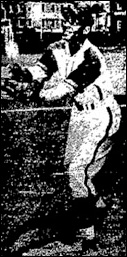


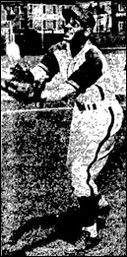
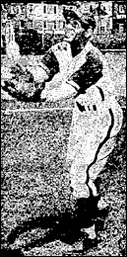
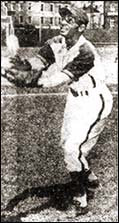
In 1947, the photo on the extreme left was identified as Howard Gay, centre fielder of the Harlem Globetrotters. (Walla Walla Union-Bulletin, July 30, 1947).
in 1949, the player in the photo second from the left was identified as Freddie Sheppard, centre fielder of the 1949 New Orleans Creoles. (The Winona Republican-Herald, July 30, 1949).
Again, in 1949, the player in the third photo is said to be Sam Wheeler, outfielder for the Globetrotters. (The Salt Lake Tribune, July 3, 1949).
In a 1952 newspaper report on the Harlem Globetrotters, the fourth photo was identified as Larry Cunningham, 'Trotters' centre fielder. (The Independent Record, Helena, Montana, June 29, 1952).
Also in 1952, the player in the fifth photo was identified as John Keen, right fielder of the Globetrotters (The Inter Lake, Kalispell, Montana, August 22, 1952).
And, we noticed another familiar photo with another different name attached -- far right, Cliff Fields of the St. Louis Stars (True Republican, June 13, 1944)
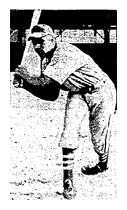
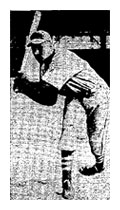
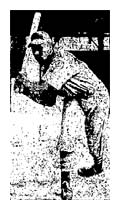
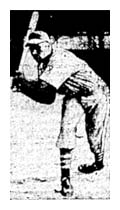
In 1941 (left) the player was identified as Lyman Bostock of the Birmingham Black Barons. (Chester Times, August 6, 1941).
Second from the left, it's 1944 and Lenan Johnson of the 'Trotters (August 18, 1944, Ogden Standard-Examiner)
Third, 1947, The News Palladium, Benton Harbor, May 29, 1947 says that's Zell Miles of the Harlem Globetrotters
09 November, 2016

![]() What a pleasant (and informative) surprise. On a visit to the village library I was asked to try and help set up a laptop with the television screen for a presentation to a group of elementary school students.
What a pleasant (and informative) surprise. On a visit to the village library I was asked to try and help set up a laptop with the television screen for a presentation to a group of elementary school students.
What caught my attention was one of the display items author Ellen Schwartz had prepared - a photo of the Vancouver Asahi baseball team. Wondering what that photo had to do with the event, I soon noticed the book - Heart of a Champion - and became aware of its connection to the famous Asahis. Ms. Schwartz was there to talk about her latest children's book (with the main character based on Kaye Kaminishi, the last surviving member of the team) :
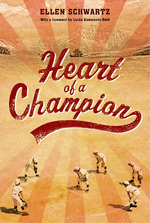 Ten-year-old Kenji (Kenny) Sakamoto worships his older brother Mitsuo (Mickey), a star on the Vancouver Asahi baseball team. Despite Kenny’s suspected heart condition, he is determined to practice secretly so that he, too, can one day try out for the Asahis. But when Japan attacks Pearl Harbor in 1941, Kenny and his family, along with thousands of other Japanese Canadians, are sent to an internment camp in the interior of British Columbia. There, Kenny struggles to keep his family’s spirits up among the deplorable conditions in the camp. Could baseball play a part in helping Kenny realize his dream?
Ten-year-old Kenji (Kenny) Sakamoto worships his older brother Mitsuo (Mickey), a star on the Vancouver Asahi baseball team. Despite Kenny’s suspected heart condition, he is determined to practice secretly so that he, too, can one day try out for the Asahis. But when Japan attacks Pearl Harbor in 1941, Kenny and his family, along with thousands of other Japanese Canadians, are sent to an internment camp in the interior of British Columbia. There, Kenny struggles to keep his family’s spirits up among the deplorable conditions in the camp. Could baseball play a part in helping Kenny realize his dream?
I sat with a group of three school classes, teachers and assistants, and a few other adults to listen in as Ellen explained how she became interested in the project, the importance of it, and how she went about her work. A prolific writer, including magazine and other articles, she has published sixteen books (both for children and adults). Heart of a Champion has received very positive reviews.
08 November, 2016
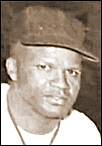
![]() One prairie summer. A lifetime friendship.
One prairie summer. A lifetime friendship.
Modie L. Risher played in my old hometown of Lloydminster for just one summer. He suited up for the Meridians for the 1957 season of the Western Canada Baseball League. No longer touted as a possible successor to Roy Campanella of the Dodgers, Risher, now approaching his 30th birthday, was urged by his long-time buddy, Curly Williams, to come North in an attempt to echo their teenage years on the diamonds of South Carolina and Florida with teams such as the Orangeburg Tigers, Charleston Black Socks and Jacksonville Eagles.
Risher made the trek from his home in Charleston, South Carolina, and became one of the team's most popular and versatile players. He was befriended by, among others, the McLean family, including young Rodney who maintained the friendship for fifty-nine years, continuing to check in to see how Modie, who lost his eyesight two decades ago, was faring. His last phone call, late last week, brought the news that Modie had passed away. He was 88.
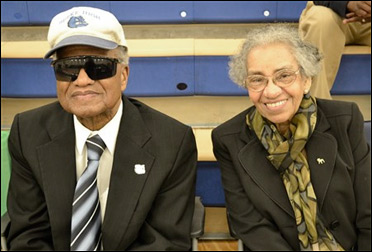
Long revered for his work in education and sports, Risher was a legendary figure in Charleston and news of his death was major news in the papers and television.
The gymnasium at Burke High School is named after Risher as is the annual high school basketball tournament which he started in 1971 after white coaches at other schools said Burke was no longer welcome at the then major high school tourney.
Left, a 2012 photo of Modie and DeLaris, his wife of 57 years. Modie Risher
21 October, 2016
![]() Baseball sleuths Rich (Necker) and The Rope (Henry Ropertz) continue their outstanding work as we fill in more game reports and photos covering four different decades.
Baseball sleuths Rich (Necker) and The Rope (Henry Ropertz) continue their outstanding work as we fill in more game reports and photos covering four different decades.
Added are the individual photos from the 1911 Kamloops squad, noted in the story below.
The 1928 season now includes Manitoba game reports and updated rosters. In 1933, we've added game reports for the 1933 Prince Albert Tournament (prompted by the interest in the win by Crooked River Lumber Jacks and the Jacks' catcher Marvin Hill).

 Our correspondents have also dug up reports and rosters for games from the West Kootenay area of BC for 1956. Photos too - (including star hurler Len Gatin, left, and Seth Martin, perhaps better known for his play in international hockey competitions). There's also the addition of the Quesnel Tournament game reports for 1956 and the start of a BC Snapshot page.
Our correspondents have also dug up reports and rosters for games from the West Kootenay area of BC for 1956. Photos too - (including star hurler Len Gatin, left, and Seth Martin, perhaps better known for his play in international hockey competitions). There's also the addition of the Quesnel Tournament game reports for 1956 and the start of a BC Snapshot page.
![]() Our thanks to fellow researcher Richard Bogovich for material from Rochester, Minnesota now posted on the 1949 Minny Snapshot page and the 1949 and 1950 Minny Photo Galleries.
Our thanks to fellow researcher Richard Bogovich for material from Rochester, Minnesota now posted on the 1949 Minny Snapshot page and the 1949 and 1950 Minny Photo Galleries.
From the 1952 Southern Minny season we've added a photo of the All-Star squad and the 1955 Minnesota Photo Galleries sport some additions.
14 October, 2016
![]() It's one of those good news, bad news days. On the good side, a phone call from Jim Lester who we've been trying to track down for the past while. Jim, who has been key to the development of this site, has had some setbacks and is currently in a nursing home in Carthage, Illinois, just outside his hometown Peoria. Back and hip problems have limited his mobility.
It's one of those good news, bad news days. On the good side, a phone call from Jim Lester who we've been trying to track down for the past while. Jim, who has been key to the development of this site, has had some setbacks and is currently in a nursing home in Carthage, Illinois, just outside his hometown Peoria. Back and hip problems have limited his mobility.
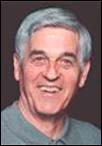 Jim brings the sad news of the passing of Dick Doepker, the Saskatchewan product who went on to star at Sequoias College and Fresno State University before a tour in pro ball in the Pittsburgh Pirates' organization. Dick died October 7th at the age of 80. After baseball he became a highly admired teacher, coach and administrator.
Jim brings the sad news of the passing of Dick Doepker, the Saskatchewan product who went on to star at Sequoias College and Fresno State University before a tour in pro ball in the Pittsburgh Pirates' organization. Dick died October 7th at the age of 80. After baseball he became a highly admired teacher, coach and administrator.
Doepker was one of twelve children (he was the youngest) and grew up in Annaheim, Saskatchewan, 125 km east of Saskatoon. He attracted the attention of the Sequoias baseball coach, Roy Taylor, in 1955 when he fired a pair of no-hitters for the Saskatoon Moores.
A "celebration of life" will be held in Visalia at the Elk's Lodge next Monday (October 17th) at one o'clock.
13 October, 2016
![]() Kamloops the 1911 amateur champions of BC ? That's what it says on the team photo of the Kamloops nine, but our Henry Ropertz (The Rope) had some reservations about the claim and thought he'd better make certain the facts before we posted a photo of the "championship" team.
Kamloops the 1911 amateur champions of BC ? That's what it says on the team photo of the Kamloops nine, but our Henry Ropertz (The Rope) had some reservations about the claim and thought he'd better make certain the facts before we posted a photo of the "championship" team.
THE DOPE FROM THE ROPE: A CLOSE LOOK AT THE EVENTS SURROUNDING THE 1911 B. C. SENIOR AMATEUR BASEBALL CHALLENGE
Nestled within the confluence of the north and south branches of the Thompson River and adjacent to the C. P. R. mainline, the community of Kamloops evolved from a fur-trading post in the early nineteenth century to incorporation as a city of 500 inhabitants in 1893. By the time 1911 rolled around, the population had swelled to 3,772 as the economy diversified, immigration intensified and amateur baseball became a growing part of the cultural landscape.
Some 220 miles westward, British Columbia’s largest city Vancouver had, according to the 1911 census, doubled in population to 120,847 during a five year span (over 32 times as many residents than Kamloops) and had become the home of a highly-successful professional baseball team, the Vancouver Beavers, champions of the 1911 Northwestern League. The pro game dominated and amateur baseball in the lower mainland, although of excellent quality, received little or no attention in the sporting sections of the competing newspapers.
Not much was unearthed in print regarding the regular-season achievements of either the newly-crowned Clovers, winners of the amateur Vancouver City League, who knocked off the defending champion Mainlands in a grueling finish or the leagueless Kamloops amateur squad. The Kamloops Standard printed only one written review of a clash involving their 1911 team, an 11 to 5 victory over the Okanagan College nine in late May. Details were sorely lacking in the rival Kamloops Inland Sentinel which mentioned a June doubleheader sweep in Revelstoke and a split-squad twin triumph in July, at home against Ashcroft and on the road in Salmon Arm. The strength and depth of the group of players was emphasized in the latter snippet which also implied that the team had strung together a “long list” of victories, many or most of which had obviously gone unreported.
At any rate, their success against opposition from the interior prompted the Kamloops squad to make a pitch for a series with the lower mainland winners, considered to be la crème de la crème amateurs within the province, with all games to be hosted by the south-central interior community where fan interest in the amateur game would presumably provide greater gate receipts. No evidence was uncovered to suggest that the series was sanctioned by the provincial amateur baseball body as a B. C. senior amateur championship. At the time that it was organized, the series appears to have been considered, by all parties, nothing more than a set of exhibition challenge matches.
The huge population imbalance between the rival urban hubs helped foster a vintage “country bumpkins” versus the “city slickers” mentality along the mainline of the interior. The extent of overt gambling on the results, so prevalent in that day and age, can only be speculated. Although nothing concrete was discovered regarding a financial purse for the event, winner take all, such a practice was not an uncommon occurrence in that era. As the 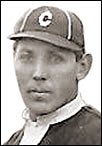 Vancouver City League champion Clovers made the trek by train into the south-central interior, they were unaware that the Kamloops team had acquired the services of ace southpaw chucker Ferdy Manning (left) , late of the professional WCBL Calgary Bronchos, to pitch for them in the upcoming best-of-three series.
Vancouver City League champion Clovers made the trek by train into the south-central interior, they were unaware that the Kamloops team had acquired the services of ace southpaw chucker Ferdy Manning (left) , late of the professional WCBL Calgary Bronchos, to pitch for them in the upcoming best-of-three series.
Manning had been in the regular pitching rotation of the Calgary Bronchos throughout the entire 1911 WCBL season (completing the campaign with a 20 – 9 record) and had taken his last turn on the mound on September 2, a win over Edmonton in the final game of the campaign. That date coincides with the rendezvous in which the Clovers captured the Vancouver City League title from the Mainlands. With the WCBL season over, Manning was available as a ringer and the Kamloops team moved quickly in making him an offer, involving incentives, to participate in their forthcoming short challenge series which took place over the weekend of September 23 - 24.
 It came as no surprise that Manning completely baffled the Vancouver amateurs with his arsenal of offerings as the hosts swept the series in two-straight contests. Reported final scores are conflicting, one mentioning a first game 5 to 0 shutout in which Manning pitched a one-hitter and whiffed seventeen, the other simply mentioning a 4 to 1 Kamloops win. Likewise, one account of the the second-game had Manning again going the route, this time a 7 to 4 conquest of the Vancouverites while the other mentions a 10 to 1 Kamloops verdict. A meaningless third game was reportedly held in which Manning, not known for his batting prowess yet playing at third base, allegedly fulfilled a bonus incentive in his short-term contact by slugging a three-run homer. In any event, Manning‘s popularity in the Thompson River community was such that he could have been elected as mayor of Kamloops. The Calgary Herald even reported that he took a post-series job tending bar at one of the principal hotels to bask in the glory. Meanwhile, the triumphant nine was overhyping their success on the diamond. What began as an merited bragging right for 1911 appears to have ultimately become transformed, in the minds of the winners, into an outright boastful claim of achieving the provincial amateur tiara.
It came as no surprise that Manning completely baffled the Vancouver amateurs with his arsenal of offerings as the hosts swept the series in two-straight contests. Reported final scores are conflicting, one mentioning a first game 5 to 0 shutout in which Manning pitched a one-hitter and whiffed seventeen, the other simply mentioning a 4 to 1 Kamloops win. Likewise, one account of the the second-game had Manning again going the route, this time a 7 to 4 conquest of the Vancouverites while the other mentions a 10 to 1 Kamloops verdict. A meaningless third game was reportedly held in which Manning, not known for his batting prowess yet playing at third base, allegedly fulfilled a bonus incentive in his short-term contact by slugging a three-run homer. In any event, Manning‘s popularity in the Thompson River community was such that he could have been elected as mayor of Kamloops. The Calgary Herald even reported that he took a post-series job tending bar at one of the principal hotels to bask in the glory. Meanwhile, the triumphant nine was overhyping their success on the diamond. What began as an merited bragging right for 1911 appears to have ultimately become transformed, in the minds of the winners, into an outright boastful claim of achieving the provincial amateur tiara.
Not surprisingly, the Kamloops-staged event was not afforded any coverage whatsoever within the Vancouver print medium nor was any mention of it as being a series with provincial championship implications made within either of the Kamloops publications. Interestingly, however, the Calgary Herald provided some details of the games as the showdown captured the attention of the Herald scribes since the focus spotlighted Broncho hurler Manning who had assumed this new role as a post-season mercenary with Kamloops and had been dominant in doing so.
Bottom line.....it is difficult for the Rope to respect the brazen Kamloops claim of outright amateur baseball supremacy. The copy of the 1911 Kamloops team composite, replete with a crest indicating “Amateur Champions . British Columbia 1911” (above) was made available to the Rope by the Kamloops Museum & Archives and does not even include a mug shot of Manning, without whose services as a hired gun, the triumph would have very likely never occurred.
[Our thanks to Scott Owens, Archivist, Kamloops Museum & Archives - Photo D-03853]
![]() Colleague Gary Fink has done some outstanding work in documenting the integration of amateur and pro ball. You'll recall his work of a few years back showing the impact of Negro League players in the ManDak League of 1950-1957. He's now put together a list of Black players in the minor and major leagues in the period 1946 to 1956. It's important and interesting research showing the pioneers in the integration of baseball.
Colleague Gary Fink has done some outstanding work in documenting the integration of amateur and pro ball. You'll recall his work of a few years back showing the impact of Negro League players in the ManDak League of 1950-1957. He's now put together a list of Black players in the minor and major leagues in the period 1946 to 1956. It's important and interesting research showing the pioneers in the integration of baseball.
11 October, 2016
![]() One of the names which drew my attention in the 1947 game reports for Vancouver and the Lower Mainland was Dick Zender of the Bellingham, WA, Bells. This was just a couple of years before the Zender's formed their own team, nine of them! Check out the 1956 and 1962 reports on the family team. The 1947 reports cover both the Vancouver Senior League and the Northwest Semi-Pro circuit.
One of the names which drew my attention in the 1947 game reports for Vancouver and the Lower Mainland was Dick Zender of the Bellingham, WA, Bells. This was just a couple of years before the Zender's formed their own team, nine of them! Check out the 1956 and 1962 reports on the family team. The 1947 reports cover both the Vancouver Senior League and the Northwest Semi-Pro circuit.

![]() Thanks again to Rich Necker, we have added game reports for 1954 BC, for all three regions - Vancouver & Lower Mainland, Victoria & Vancouver Island and the BC Interior. Wish we had more information on Charlie Boyd (left) of Victoria's Farmer Construction in '54. Quite the slugger. Assume it's the same Charlie Boyd who played with Cumberland and Campbell River in the late 40s and 50s.
Thanks again to Rich Necker, we have added game reports for 1954 BC, for all three regions - Vancouver & Lower Mainland, Victoria & Vancouver Island and the BC Interior. Wish we had more information on Charlie Boyd (left) of Victoria's Farmer Construction in '54. Quite the slugger. Assume it's the same Charlie Boyd who played with Cumberland and Campbell River in the late 40s and 50s.
Also, there are BC game reports for Victoria & Vancouver Island for 1955. Boyd was again a major contributor for Victoria. Looking for more information on Fred Christensen of Prince Rupert who fired a no-hitter and a one-hitter in his first few starts for Victoria.
The 1954 Tournament page has the additions of three big BC tournaments.
A few specific events have also been added including the 1946 Medicine Hat Tournament in which the amazing Sceptre nine captured yet another top prize. Cliff "Jake" Jacobson hurled 18 shutout innings for Sceptre.
And, of course, with all of the game report pages, the roster pages are updated accordingly.


![]() The 1938 edition of the Vancouver Asahi were particularly successful winning the Burrard League championship then defeating the Commercial League champs in a challenge series. To crown their campaign, the Asahi captured the Pacific Northwest Japanese title.
The 1938 edition of the Vancouver Asahi were particularly successful winning the Burrard League championship then defeating the Commercial League champs in a challenge series. To crown their campaign, the Asahi captured the Pacific Northwest Japanese title.
We've located some good individual photos of the members of the 1938 club and they are now posted on the BC Photo Gallery for that season. Kaz Suga (left), and Roy Yamamura (right) were two of the enduring stars.
05 October, 2016
![]() Rich "Sherlock" Necker has had a busy summer uncovering more and more baseball in the west. We're still playing catch-up, especially with game reports, and offer more this week.
Rich "Sherlock" Necker has had a busy summer uncovering more and more baseball in the west. We're still playing catch-up, especially with game reports, and offer more this week.
Saskatchewan has a 1916 page for game reports and for Manitoba we've added summaries for the 1919 Winnipeg Senior League, which is of special interest as it pinned down the start of Lefty Kaye's career. Kaye would later star in BC ball.
In the 1920 Vancouver game reports, we've added the final standings for the Commercial League.
The 1921 game reports for Vancouver & Lower Mainland include stories on the Vancouver City League, Vancouver Commercial League, Vancouver Terminal League, Dewdney League Twilight League, New Westminster Senior League and the Senior playoffs.
There's also the start of a page for the BC Interior.
In the 1922 Vancouver game reports we've posted notes on a pair of no-hitters (within a week in May), one in the Vancouver Senior League by Ivan MacDonald and the other in the Terminal League by Nick Craig.
We've moved some game summaries from the home pages to specific region pages for 1922 and 1923, thus - Saskatchewan 1922, 1923 & Alberta 1922 & 1923.
In addition, we've expanded the game reports for 1926 with news on the BC Playoffs in both Senior A and Senior B mainly in the Vancouver/Lower Mainland area plus game reports for the BC Interior -- West Kootenays and Mainline League. The 1926 roster page reflects the additions.
![]() The new section on Minnesota baseball has updates and/or additions all over the place, including rosters, photos (below left to right - Augie Schlaffer, Sam "Red" Jones, Bill Skowron, Art Pennington and a sketch of Don "Gabby" Hormann), snapshots, stats and a game report or two as well. Among the team photos is one of the 1947 Albert Lea Packers. There are also lists of the batting champions (1948 to 1957) and the South Minny records from 1948 to 1957.
The new section on Minnesota baseball has updates and/or additions all over the place, including rosters, photos (below left to right - Augie Schlaffer, Sam "Red" Jones, Bill Skowron, Art Pennington and a sketch of Don "Gabby" Hormann), snapshots, stats and a game report or two as well. Among the team photos is one of the 1947 Albert Lea Packers. There are also lists of the batting champions (1948 to 1957) and the South Minny records from 1948 to 1957.
Much thanks to Richard Bogovich for material on the Rochester Royals, including the picture of Sam Jones on the 1949 Snapshot Page and the confirmation of the 23-strikeout game of Jerry Wickham in 1965. More from Richard to follow soon.
The rosters are now pretty well complete from 1948 through 1957 with 1965 also posted. We have league statistics for the 1949 season through 1957. So far we'll be unsuccessful in locating stats from pre-1949 and post 1957 seasons.
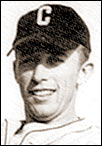

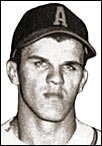
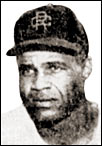
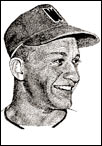
Seems Hormann was quite the ladies' man during his tenure in the South Minnesota League. And (as we noted in an earlier update) he became known in the off-season for venture into cowboy music as "Webb Foley".
Members of the 1950s Winona Chiefs baseball club were, by all accounts, treated like movie stars during pro baseball's peak years of popularity in Winona.
Fans flocked to games by the thousands. Images of the players floated around town on posters, trading cards and newspaper pages. Chiefs manager Hugh Orphan allegedly claimed that the hardest part of his job was keeping his popular, young, single players focused on baseball instead of their adoring fan base (mostly young women). When the era of movie stardom for ball players departed Winona, the Chiefs returned to lives of quiet obscurity and family values.
All but one, that is. Gabby Horman <sic> was perhaps the most popular Chiefs player of the 1950s, with the young ladies of Winona especially. In addition to starting as catcher for the local club, Horman was an aspiring rockabilly musician. Often, Horman would take the mound after Chiefs victories for impromptu concerts. Whether to listen to his crooning of the self-written tune Moon Over Sugar Loaf, or simply to admire his good looks, young ladies flocked to the field for these post-game performances.
Legend has it that Horman, in true Conrad Birdie fashion, lifted the heart rate of every woman in Winona whenever he passed them on the street. Some ladies, eager for a personal slice of Horman's hunk-pie, called him out of the blue. This was fine and dandy for Horman and his followers, but the poor Winona family whose phone number was just a digit away from Horman's didn't appreciate the phenomenon. Once, when the mother of this family told a mistaken caller that Horman didn't live in her home, the caller angrily replied, "Oh! You just want to keep him all for yourself!," then hung up, stricken with heartache. [By Brian P. Heilman, former reporter Winona Post]
30 September, 2016
![]() It's a rarity now -- a good hitting pitcher. Don Newcombe of the Dodgers was quite the pitcher-hitter in the 1950s (359 .395 .632, 7 homers in 1955) but today hurlers such as the Giants' Madison Bumgarner are cited as hitting stars because of his three homers and a .171 average.
It's a rarity now -- a good hitting pitcher. Don Newcombe of the Dodgers was quite the pitcher-hitter in the 1950s (359 .395 .632, 7 homers in 1955) but today hurlers such as the Giants' Madison Bumgarner are cited as hitting stars because of his three homers and a .171 average.
 In our continuing coverage of 1927 baseball in British Columbia, we note the outstanding performance of Dave Gray of Burnaby in the Terminal League. The right-hander not only led the circuit in his mound work (with a 15-4 record) he smacked the ball at a .387 clip to finish third in the batting race.
In our continuing coverage of 1927 baseball in British Columbia, we note the outstanding performance of Dave Gray of Burnaby in the Terminal League. The right-hander not only led the circuit in his mound work (with a 15-4 record) he smacked the ball at a .387 clip to finish third in the batting race.
With our thanks to ace researcher/reporters Rich Necker and Henry Ropertz we have tidied up and added 1927 game reports for Vancouver & the Lower Mainland, Vancouver Island, and the BC Interior, including playoffs.
Additional game reports for 1927 are also available for Alberta and Manitoba.
And, as noted in an earlier update, statistics for 1927 are now posted for the Winnipeg Senior League, Vancouver Senior loop, Vancouver Terminal League, Victoria Senior League and New Westminster & District League.
![]() The statistics are among the more difficult tasks we face. Finding them is the first order of business and so often that proves to be fruitless. Once found, however, the problem shifts to being able to decipher the old print in the fading newspapers and to re-calculate the numbers to determine if the statisticians of the day were on with their mathematics. Or perhaps the newspaper production process might not have been perfect. In a surprising number of cases, the old time scorekeepers did first rate work. Remember, in those days somebody had to do all of it by hand, no calculators, no computers, no spreadsheets. Thanks to Rich Necker and Henry Ropertz we've been able to make some significant additions to our stat pages.
The statistics are among the more difficult tasks we face. Finding them is the first order of business and so often that proves to be fruitless. Once found, however, the problem shifts to being able to decipher the old print in the fading newspapers and to re-calculate the numbers to determine if the statisticians of the day were on with their mathematics. Or perhaps the newspaper production process might not have been perfect. In a surprising number of cases, the old time scorekeepers did first rate work. Remember, in those days somebody had to do all of it by hand, no calculators, no computers, no spreadsheets. Thanks to Rich Necker and Henry Ropertz we've been able to make some significant additions to our stat pages.
The 1920 stats page now includes the Vancouver City League and the Vancouver Commercial League. On the 1922 stats page we've also added the three circuits from the BC Lower Mainland -- Vancouver Terminal League, Twilight League and Fraser Valley League.
The 1954 and 1955 stats have been updated to include BC's Comox District League.
Stats for the Winnipeg Senior League have been posted for 1919, 1920, 1922, 1927, 1928 and 1932.
19 September, 2016
![]() An inquiry from Paul Hill has resulted in another addition to the team photo section and a little more information about 1930s baseball in Saskatchewan. Paul had a photo of the 1933 Crooked River Lumber Jacks and was hoping to ID a relative,
An inquiry from Paul Hill has resulted in another addition to the team photo section and a little more information about 1930s baseball in Saskatchewan. Paul had a photo of the 1933 Crooked River Lumber Jacks and was hoping to ID a relative,  Marvin Hill. Information with the picture had the team winning the Diefenbaker Trophy (John Diefenbaker became Canada's Prime Minster in the late 1950s). We were able to ascertain that the trophy was a prize for winning the Prince Albert Baseball Tournament and that Hill was the catcher for the team and thus, easily identified in the photo (back row, extreme right) as the player with the catching gear.
Marvin Hill. Information with the picture had the team winning the Diefenbaker Trophy (John Diefenbaker became Canada's Prime Minster in the late 1950s). We were able to ascertain that the trophy was a prize for winning the Prince Albert Baseball Tournament and that Hill was the catcher for the team and thus, easily identified in the photo (back row, extreme right) as the player with the catching gear.
![]() Kudos to Richard Bogovich ! Richard, a fellow SABR member, was kind enough to check out microfilm of the Rochester, Minnesota, papers for some key information on Southern Minnesota baseball, including a Sam Jones no-hitter.
Kudos to Richard Bogovich ! Richard, a fellow SABR member, was kind enough to check out microfilm of the Rochester, Minnesota, papers for some key information on Southern Minnesota baseball, including a Sam Jones no-hitter.
![]() We've been lucky to have stumbled upon a few more team photos including the 1904 Calgary Tigers (highlighted previously). From Manitoba baseball we've uncovered pictures of the 1917, 1922 and 1923 Winnipeg Arenas, 1919 Winnipeg Granite, 1920 Transcona, 1922 Winnipeg Catholic Club, 1922 Portage La Prairie and the 1948 Winnipeg Junior All-Stars (noted earlier).
We've been lucky to have stumbled upon a few more team photos including the 1904 Calgary Tigers (highlighted previously). From Manitoba baseball we've uncovered pictures of the 1917, 1922 and 1923 Winnipeg Arenas, 1919 Winnipeg Granite, 1920 Transcona, 1922 Winnipeg Catholic Club, 1922 Portage La Prairie and the 1948 Winnipeg Junior All-Stars (noted earlier).
To add to the coverage of baseball in British Columbia there's the 1926 Squamish, BC club, and the 1960 Squamish nine.
And, as noted below, we've added two new photos of the 1948 Fort Wayne Electrics, the losers to London, Ontario, Majors in the North American semi-pro championship that season.
The quality on more than a few of the above is much less than desired, but, at very least provide a place holder for when we manage to dig out better versions.
![]() There are a couple of new Manitoba Snapshot pages, 1932 and 1933, for photos of 1932 batting champion Jack Menzies and 1933 playing-manager Jimmy Grant.
There are a couple of new Manitoba Snapshot pages, 1932 and 1933, for photos of 1932 batting champion Jack Menzies and 1933 playing-manager Jimmy Grant.
![]() One more lesson in "Never Assume Anything". It's the Southern Minnesota League, 1949. Owatonna had a first sacker Leo Nowak. Well, he was Leo until another newspaper report had him pegged as Lloyd Nowak. Then, after a mention that he had a pro career and his name might be Wally, we did yet another check and it turns out this was Walter (Wally) Nowak. A few years later (1953) the statistics for the SMBL show a NOWKA, no first name, in the lineup for Owatonna. Seems to be a reasonable assumption that Nowka was a simple typo for NOWAK. Same name, same team. Right? Except there was a college outfielder (Wisconsin) at the time named Jack Nowka. Yep, turns out it was Jack Nowka who played a couple of games for Owatonna in '53.
One more lesson in "Never Assume Anything". It's the Southern Minnesota League, 1949. Owatonna had a first sacker Leo Nowak. Well, he was Leo until another newspaper report had him pegged as Lloyd Nowak. Then, after a mention that he had a pro career and his name might be Wally, we did yet another check and it turns out this was Walter (Wally) Nowak. A few years later (1953) the statistics for the SMBL show a NOWKA, no first name, in the lineup for Owatonna. Seems to be a reasonable assumption that Nowka was a simple typo for NOWAK. Same name, same team. Right? Except there was a college outfielder (Wisconsin) at the time named Jack Nowka. Yep, turns out it was Jack Nowka who played a couple of games for Owatonna in '53.
![]() Weeks of trying without success to get in touch with Jim Lester (Peoria, Illinois) Anybody with info ?
Weeks of trying without success to get in touch with Jim Lester (Peoria, Illinois) Anybody with info ?
12 September, 2016

![]() Jack Cranstoun, an import from Regina, had quite the 1927 season in the Vancouver Senior League. In winning the batting crown, all Cranstoun achieved was an average of .516 in 65 at bats. He finished more than 100 points ahead of the runner-up.
Jack Cranstoun, an import from Regina, had quite the 1927 season in the Vancouver Senior League. In winning the batting crown, all Cranstoun achieved was an average of .516 in 65 at bats. He finished more than 100 points ahead of the runner-up.
The 1927 BC stats provide some pretty convincing evidence that the hitters performed a lot better than the pitchers. Along with Cranstoun's amazing season Don McLean topped that, hitting .518 in the Terminal League, while Jerry Reynolds took the title in the New Westminster & District League with "only" a .419 average. The finish in the Victoria Senior League couldn't have been a whole lot closer as Ross Oatman wrapped up the season with an average of ..3733 to edge Bill Holman, at .,3728.
The 1927 season is now well documented as Rich Necker provides game reports for 1927 in the Vancouver Senior City League, Vancouver Terminal League, New Westminster & District League, Senior "A" and Senior "B" playoffs, Victoria Senior Amateur League and West Kootenay League. The Vancouver reports also feature three cartoon panels that were published during the 1927 season.
This goes along with the 1927 reports and stats for the Winnipeg Wesley Senior League in Manitoba.
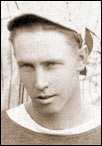
![]() As detailed in the above updates, the Rossland Miners of the BC Interior captured the provincial Senior "A" title for the second straight season. We're still on the lookout for a photo of the 1927 team, but it appears the lineup is quite similar to the 1926 Rossland nine. We've now extracted the individual photos for the 1926 Photo Gallery. Harry Cobain (left) was a star hurler for the Miners.
As detailed in the above updates, the Rossland Miners of the BC Interior captured the provincial Senior "A" title for the second straight season. We're still on the lookout for a photo of the 1927 team, but it appears the lineup is quite similar to the 1926 Rossland nine. We've now extracted the individual photos for the 1926 Photo Gallery. Harry Cobain (left) was a star hurler for the Miners.

![]() What a nice accidental finding, photographs of the 1948 Fort Wayne Electrics, the team defeated by the London, Ontario, Majors for the 1948 North American semi-pro title.
What a nice accidental finding, photographs of the 1948 Fort Wayne Electrics, the team defeated by the London, Ontario, Majors for the 1948 North American semi-pro title.
And, a discovery within the discovery - soon-to-be major leaguer Chuck Harmon (right). Also on the Fort Wayne Electrics were a couple of players who went on to suit up in the Southern Minnesota League, Hugh Orphan and Bill Brandt.


![]() The new section of Minnesota amateur and semi-pro ball has dozens of additions and updates, mainly in the Photo Galleries, all the links in the Southern Minny home page. Included are individual photos, such as Paul Giel (left), the football and baseball star, and Bud Grant, (right) who was an all-star football player and head coach in Winnipeg, along with snapshots, such as those from the 1948 championship. The home page includes the start of a list of league, playoff and state champions.
The new section of Minnesota amateur and semi-pro ball has dozens of additions and updates, mainly in the Photo Galleries, all the links in the Southern Minny home page. Included are individual photos, such as Paul Giel (left), the football and baseball star, and Bud Grant, (right) who was an all-star football player and head coach in Winnipeg, along with snapshots, such as those from the 1948 championship. The home page includes the start of a list of league, playoff and state champions.
![]() Good to hear from Phil Risinger, the former Medicine Hat star, who sends along some photos and information from Oklahoma.
Good to hear from Phil Risinger, the former Medicine Hat star, who sends along some photos and information from Oklahoma.
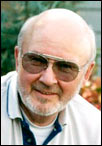
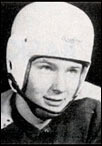
![]() Sad news from the old hometown, the passing of Norman Thorpe of Lloydminster. He died on August 28th at the age of 79. Norm was an outstanding athlete - hockey, football, baseball - who continued to play hockey (goalie) into his senior years with the Never Sweats.
Sad news from the old hometown, the passing of Norman Thorpe of Lloydminster. He died on August 28th at the age of 79. Norm was an outstanding athlete - hockey, football, baseball - who continued to play hockey (goalie) into his senior years with the Never Sweats.
Norm was of great assistance to our projects, both our Western Canada Baseball effort and another on Lloydminster itself. He had such a tough time the last few years, battling Parkinson's disease and dealing with the death of his wife Marilyn four years ago.
05 September, 2016
![]() One more step forward - Minnesota amateur and semi-pro ball.
One more step forward - Minnesota amateur and semi-pro ball.
We have kicked off a project to try and detail amateur and semi-pro baseball in Minnesota in the era from the end of the war to the mid 1960s (1945 to 1966). The initial focus is on the Southern Minny League which included such communities as Albert Lea, Austin, Rochester, Winona, Owatonna, Waseca, Mankato and Faribault.
With the much appreciated assistance of Armand Peterson, co-author of Town Ball, The Glory Days of Minnesota Amateur Baseball, and others we have begun to compile the teams, rosters, statistics, standings, and photos. There's even the odd game report.
There is a base page for Minny ball and the same material can be accessed through the site map or through the decade links above.

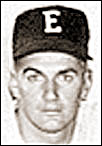 A couple of initial points of interest - Sam "Red" Jones (left) fired a pair of no-hitters for the Rochester Royals in the 1949 season before going on to major league success.
A couple of initial points of interest - Sam "Red" Jones (left) fired a pair of no-hitters for the Rochester Royals in the 1949 season before going on to major league success.
And, former Edmonton Eskimo Ernie/Gordon Nevers (right) shows up in the Southern Minny loop with Bloomington in the early 1960s and creates a stir with his strikeout performances. Nevers - real first name Gordon - used Ernie for the most part to honour of his great uncle, the famous football star.
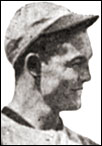
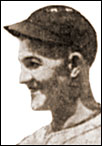
![]() Was that Herman Pillette (right) or younger brother Ted Pillette (left) who tossed the no-hitter in Vancouver on June 4, 1935?
Was that Herman Pillette (right) or younger brother Ted Pillette (left) who tossed the no-hitter in Vancouver on June 4, 1935?
Without the actual clipping, at the time, to confirm which of Pillette's was on the hill for Bellingham, WA we came to the obvious conclusion that it was Ted, who had ended his pro career the previous season and began playing semi-pro ball in the Oregon State League, not far from Bellingham. Herman, released by Seattle of the Pacific Coast League on May 29th, had quickly (June 1st) been snapped up by Hollywood of the same loop. It seemed to make sense that Herman, having signed a contract on the first of June for another hitch in pro ball, wouldn't be tossing semi-pro ball up in Vancouver a few days later. Well, it turns out it was Herman. Henry "Red Eye" Ropertz sends along the newspaper clipping to confirm.
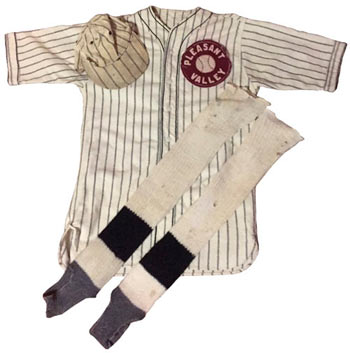
![]() Can you help on this ?
Can you help on this ?
It's a uniform discovered in Grandview, Manitoba, believed to be from around 1949. The crest says Pleasant Valley.
Mike Krykewich of Winnipeg (a Manitoba Hall of Fame inductee this summer) is anxious to identify the uniform.
Pleasant Valley - Manitoba? Saskatchewan? Iowa? Minnesota?
If you can help, please drop us a line. Thanks . ![]()
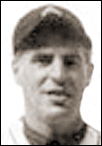
![]() Another side of the Casey Jones (see below) problem is a player with different spellings of his surname. There are many dozens of those (think of Johnston / Johnston / Johnstone or Smith / Smythe or Brautigam / Brautigan / Braudigan / Bordigan or Christianson / Christensen / Christenson or McDonald / MacDonald. Well, there's now one less. Vancouver Island ball had one of those in the 1940s and 1950s in Johnny Haramboure / Harambourne.
Another side of the Casey Jones (see below) problem is a player with different spellings of his surname. There are many dozens of those (think of Johnston / Johnston / Johnstone or Smith / Smythe or Brautigam / Brautigan / Braudigan / Bordigan or Christianson / Christensen / Christenson or McDonald / MacDonald. Well, there's now one less. Vancouver Island ball had one of those in the 1940s and 1950s in Johnny Haramboure / Harambourne.
A check of the voting list records of the day points to Haramboure (no "n"). So, we've made the change throughout the site. Oh, could it have been Jack Haramboure? Well, we have seen that a time or two, but for now we're sticking with Johnny.
30 August, 2016
![]() Pictures, pictures, pictures.
Pictures, pictures, pictures.
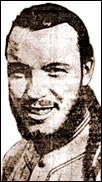 Rich Necker's flipping through the old Manitoba, and other, papers (Henry Ropertz has also contributed here) has resulted in dozens and dozens of photo additions to help spice up the coverage on our site.
Rich Necker's flipping through the old Manitoba, and other, papers (Henry Ropertz has also contributed here) has resulted in dozens and dozens of photo additions to help spice up the coverage on our site.
A few have proven a tad difficult to identify, such as the star from the House of David nine from Benton Harbour, Michigan, who were regular visitors to the prairies entertaining fans with their distinctive bearded appearance and pepper game.
In promoting a 1927 visit to Vancouver, there was a photo in the paper of a Jimmy Faust identified as a mainstay of that crowd-pleasing pepper game. Our conclusion is that it's really shortstop Walter "Dutch" Faust (left) who gained a reputation as one of the all-time best of the House of David barnstormers.


![]() The photo additions are most prominent in the Manitoba Photo Galleries and Snapshots -- 1903, 1916, 1917, 1919, 1920, 1921, 1922, 1923, 1924, 1925, 1927, 1928, 1930, 1931, 1948 and 1949. There's also a start to the 1921 Manitoba Snapshot page (with an example of the major attention the papers paid to the local baseball scene), 1922 and one for Manitoba in 1928 as well. The 1928 page reinforces the view of deep interest in local ball. Among the entries are some famous names in Manitoba baseball - Ward McVey, Dick Irvin (left - he of later hockey fame), Steamer Maxwell (right), Doc Flanagan, Gordon Caslake, Bunny Warren.
The photo additions are most prominent in the Manitoba Photo Galleries and Snapshots -- 1903, 1916, 1917, 1919, 1920, 1921, 1922, 1923, 1924, 1925, 1927, 1928, 1930, 1931, 1948 and 1949. There's also a start to the 1921 Manitoba Snapshot page (with an example of the major attention the papers paid to the local baseball scene), 1922 and one for Manitoba in 1928 as well. The 1928 page reinforces the view of deep interest in local ball. Among the entries are some famous names in Manitoba baseball - Ward McVey, Dick Irvin (left - he of later hockey fame), Steamer Maxwell (right), Doc Flanagan, Gordon Caslake, Bunny Warren.
 It's not very good photo, but we were really pleased to come across a picture of Casey Jones, a Winnipeg first sacker back in the early 1930s. Particularly happy because the paper also provided a first name! Ed.
It's not very good photo, but we were really pleased to come across a picture of Casey Jones, a Winnipeg first sacker back in the early 1930s. Particularly happy because the paper also provided a first name! Ed.
I'm uncertain of the origin (Casey Jones, the famous railroad engineer?), but the moniker "Casey" for a player named Jones was so commonplace in that era and was a major barrier to properly identifying these players as all across Canada and the United States there were dozens of Casey Jones.
We did not neglect the rest of the West.
There's the start of an Alberta Photo Gallery for 1904 and one for BC in 1905. And as we skip ahead to 1947, 1954 and 1955, some new photos in the BC Galleries. There's even a photo addition for the Ontario Photo Gallery of 1955 - Al Dumouchelle, who pitched in Ontario's Intercounty League after a stint with a military team in Saskatoon in 1943.
The snapshot pages of interest from the early years are in 1902, and 1905, Then there's some pictures on the 1926 BC Snapshot page, a new photo of Alberta star pitcher Si Siler on the 1927 page, and one the famous Negro hurler John Donaldson in 1928, and an addition to the 1947 BC Snapshots. The 1955 BC snapshot page offers some additions specific to Vancouver Island baseball.
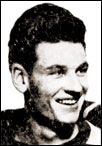
![]() Here's one more hockey star who was pretty good on the diamond as well. From New York, Michael Arundel was in touch about a baseball team photo hanging in his hallway along with other pictures of his father, Johnny Arundel, better known for his prowess on the ice as a hockey player -- one who made the National Hockey League with the Toronto Maple Leafs.
Here's one more hockey star who was pretty good on the diamond as well. From New York, Michael Arundel was in touch about a baseball team photo hanging in his hallway along with other pictures of his father, Johnny Arundel, better known for his prowess on the ice as a hockey player -- one who made the National Hockey League with the Toronto Maple Leafs.
The photo, not identified to Michael, turned out to be the Winnipeg, South Division Junior All-Stars in 1948. His dad is in the front row, extreme left. We could quickly ID the photo as we've had a poor quality newspaper version of it sitting on the shelf. Michael, who sent along a copy of the photo, kindly gave permission for use on our site. His dad, while a junior, played a bit with senior clubs in Winnipeg.
![]() Brian Morrison, Diamonds in the Dusk, has a nice piece on a former Western Canadian hurler who had played in the majors -- Clarence Currie. Currie pitched in 15 games for the Moose Jaw Robin Hoods back in 1909 near the end of his career. Near the beginning, he fashioned a 22-0 record one season in the semi-pro Wisconsin State League.
Brian Morrison, Diamonds in the Dusk, has a nice piece on a former Western Canadian hurler who had played in the majors -- Clarence Currie. Currie pitched in 15 games for the Moose Jaw Robin Hoods back in 1909 near the end of his career. Near the beginning, he fashioned a 22-0 record one season in the semi-pro Wisconsin State League.
25 August, 2016
![]() So, how did the "American game" make such headroads in Western Canada in such a short period of time in the early 1900s ?
So, how did the "American game" make such headroads in Western Canada in such a short period of time in the early 1900s ?
A headline in the Minneapolis Journal, September 30, 1902, provides an answer.
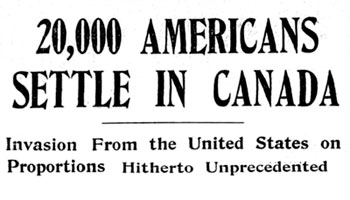
A story in the Winnipeg Tribune (February 25, 1904) under a header "American Invasion" noted the amazing turnaround in movement between Canada and the United States.
The trend of population was from Canada to the United States for many years. The Dominion lost the most enterprising and most energetic of her young men, who preferred the larger opportunities of life in the neighboring republic. In 1896 there were so few Americans coming this way the government did not think it worth while keeping track of their number. But in the twelve months up to July last, the returns showed that the American invasion, as it was called, represented of movement of fifty thousand souls. In the last half of 1903 Canada got 21,145 Americans more, and the prospects are that next season this showing will be at least fully maintained if it is not improved.
They came from almost every state of the Union (in the fiscal year of 1902), from the 4,646 from Minnesota to the 14 from Alabama and 2 from Florida.
The Canadian government had widely advertised for homesteaders by offering free land (160 acres) with the settlers required to build a house and make improvements within three years. (There was a $10 administration fee.) Americans were especially welcome.
The American is a most desirable settler. he is accustomed to labor-saving methods of farming, is of kindred race and speech, and is governed by similar laws. He assimilates at once with his new environment, and becomes as loyal a Canadian as he was an American. For these reasons the people of Western Canada wish all success to the efforts being made to induce increasing numbers to take up land in the Fertile Belt. (Manitoba Morning Free Press, December 10, 1902)
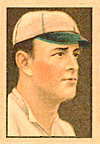
![]() Former major leaguer Joe Kutina and two brothers were part of the American Invasion of the next decade trying to establish their farming operation in the Rimbey area of Alberta. Up to now we've relied on an account in a Rimbey history book to confirm Kutina's play in Canada, but now we've finally dug up game reports and box scores showing Joe and his brother Bill in the lineup for the Edmonton Veterans in 1919.
Former major leaguer Joe Kutina and two brothers were part of the American Invasion of the next decade trying to establish their farming operation in the Rimbey area of Alberta. Up to now we've relied on an account in a Rimbey history book to confirm Kutina's play in Canada, but now we've finally dug up game reports and box scores showing Joe and his brother Bill in the lineup for the Edmonton Veterans in 1919.
![]() Our Rich Necker continues to amaze with more and more material from the early years, the latest coverage from 1905 and 1906, including the early version of "there's no crying in baseball".
Our Rich Necker continues to amaze with more and more material from the early years, the latest coverage from 1905 and 1906, including the early version of "there's no crying in baseball".
"After feeding the Wetaskiwin bunch honey all week and throwing in a big fill about what nice folks they were, the Edmonton bunch turned on them last night like a band of hungry wolves and tore them loose from their collateral and their fame, leaving the young bears a wreck to limp home on three legs and tell the story in their own camp of how cruelly they were traduced and buncoed. It was cold-blooded, but as sympathy has no place in baseball it was a la mode." (Edmonton Bulletin, July 7, 1906)
The 1906 Alberta game reports present a near complete view of the Calgary season, including some batting and pitching statistics and game reports.
A highlight of the season in Northern Alberta was the arrival of the Anacortes team from Washington for a series of exhibition games. A member of the team was William F. “Deacon” White who became enamoured by the new province and in particular, Edmonton, and decided to stay. He went on to quickly establish himself as the area’s first promoter of big-league sport by helping to build baseball, football and hockey organizations in the thriving Capital city.
The difficulty in tracking down game by game results from the early years is exemplified by the following report from a 1903 paper :
On Saturday afternoon on the Mission diamond the Calgary Stars fell down before the Midnapore baseball team in a nine innings game.
Quite a number of the fans were present to watch the game and as each team had their rooters along the contest became very exciting.
In the fifth innings D. aPtton (sic - likely Patton) , one of the Midnapore boys received an ugly gash on his finger, but played the game through.
John Donohoe, the president of the Star club, also received a scorching foul tip ball on the hip, which nearly put him out of commision.
In the evening the Stars entertained the "Mids" to a supper.
1905 Home Page Tournaments/Exhibitions Rosters
Manitoba Game Reports
Alberta Game Reports Snapshots
Assiniboia & Saskatchewan Game Reports
British Columbia Game Reports Photo Gallery
Manitoba Game Reports
Alberta Game Reports
Saskatchewan Game Reports
British Columbia Game Reports
![]() Rich continues to chase the Crosseti story. We're trying to track down confirmation that the famous New York Yankee shortstop Frank Crosseti played some senior baseball in Cumberland on Vancouver Island in 1925 or 1926. Rich even tracked down Crosseti's daughter in California and twice spoke with her on the phone but she could not recall any conversations about her father playing ball in Canada. Crosetti's widow, now 102, could not remember a Canadian connection, but did recall his year as a teenage semi-pro in Montana. The search continues.
Rich continues to chase the Crosseti story. We're trying to track down confirmation that the famous New York Yankee shortstop Frank Crosseti played some senior baseball in Cumberland on Vancouver Island in 1925 or 1926. Rich even tracked down Crosseti's daughter in California and twice spoke with her on the phone but she could not recall any conversations about her father playing ball in Canada. Crosetti's widow, now 102, could not remember a Canadian connection, but did recall his year as a teenage semi-pro in Montana. The search continues.
22 August, 2016
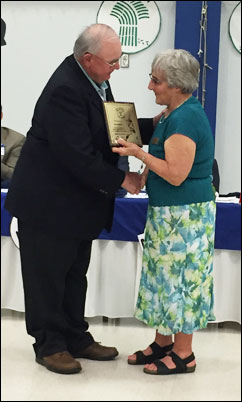
![]() A big day in Battleford, Saskatchewan Saturday as the Saskatchewan Baseball Hall of Fame held its annual induction ceremony.
A big day in Battleford, Saskatchewan Saturday as the Saskatchewan Baseball Hall of Fame held its annual induction ceremony.
Left - That's Lloydminster's Leo Wurtz receiving his award from the HOF's Jane Shury.
Fourteen individuals, three teams, a family and a community were saluted.
The three teams were the Leader Barons Senior team of 1961 to 1983, Viceroy 1946 to 1975 and the Marysburg Royals Senior team featuring the Strueby family. The family honoured was the Lloyd clan of Swift Current. And, Lloydminster won recognition as the community.
The individuals were Doug Dodd, Ron Bauml, Lewis McNamee, Fabian Schommer and below, top row (left to right) - Leo Wurtz, Barry Erickson, Robert W. Thompson, Harvey Schmidt, Corky McCann and bottom row (left to right) , Laurence Woodard, Norm Loehr, Regan Kjargaard, Bev Hickie, Terry Buck.

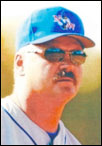
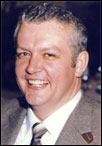
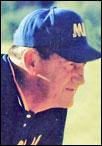
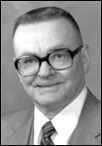
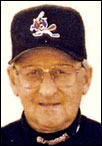
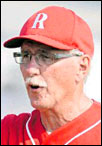

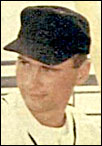

![]() Loud complaints in the early years, especially in 1904, about sporting events on Sunday, prompted the Canadian government to ban business activities on Sundays with the Lord's Day Act enacted in 1906. The law would remain in effect until 1985. It's one of the interesting findings out of the game reports from the early years of baseball in Western Canada. Thanks to ace researcher Rich Necker we begin in fill in details of diamond activities in 1902, 1903 and 1904.
Loud complaints in the early years, especially in 1904, about sporting events on Sunday, prompted the Canadian government to ban business activities on Sundays with the Lord's Day Act enacted in 1906. The law would remain in effect until 1985. It's one of the interesting findings out of the game reports from the early years of baseball in Western Canada. Thanks to ace researcher Rich Necker we begin in fill in details of diamond activities in 1902, 1903 and 1904.
In 1904 there's the challenge of the Calgary Tigers for the Western Canadian championship (and the marvelous discovery of a photo of the 1904 team).
There's also the mystery of Fillmore, the ace Winnipeg hurler, who throughout his career never seemed to get rewarded with a first name. Turns out he was William Parker Fillmore, born in Iowa, who came to Winnipeg in 1902 but returned to Iowa for university. He graduated in law and was a fixture in Manitoba legal circles for decades. There's still a law firm with his name attached. His grandson, W. Parker Fillmore, is a Winnipeg lawyer. In the 1904 season, he didn't join the Winnipeg Senior League until late June and still went to the mound nine times, eight wins and a tie, nine complete games, two shutouts.
1902 - Manitoba, Assiniboia & Saskatchewan, British Columbia, Alberta, BC Photo Gallery, BC Snapshots, Rosters
1903 - Manitoba, Alberta, Assiniboia & Saskatchewan, British Columbia, Manitoba Photo Gallery, Rosters
1904 - Manitoba, Alberta, Assiniboia & Saskatchewan, British Columbia, Alberta Photo Gallery, Calgary Tigers, Rosters
![]() This is neat. Rich Necker noticed this wonderful mural in Moose Jaw. It celebrates the opening of the 1910 season in the Saskatchewan city. The Robin Hoods won the opener 4-2 over Brandon. The local paper offered this report on the big day.
This is neat. Rich Necker noticed this wonderful mural in Moose Jaw. It celebrates the opening of the 1910 season in the Saskatchewan city. The Robin Hoods won the opener 4-2 over Brandon. The local paper offered this report on the big day.
With a flourish of triumphs, literally and figuratively, the base ball season opened amidst a blaze of enthusiasm yesterday. All this enthusiasm was justified. Fans had been assured that the class of ball to be played this year would be much better than last, and that the team this year would be a real winner. But who would not be enthusiastic on the opening of the season. Even the heart of the city born kid is warmed when he thinks of that first game to be played on the nearest vacant lot and the fans in Moose Jaw who are given the opportunity of seeing such a class of ball as played yesterday would be very much lacking in vim and enthusiasm if they did not appreciate the sport and show their appreciation in the manner which counts.
An automobile parade led by the 16th Light Horse Band gave to the occasion a gala touch. As the various vehicles wound their way through the streets to the strains of martial music it seemed that Moose Jaw was en fete. The interest and support given by all sections and classes of the community were fitting tributes to en enterprise of the directors and executive of the Moose Jaw Baseball club.
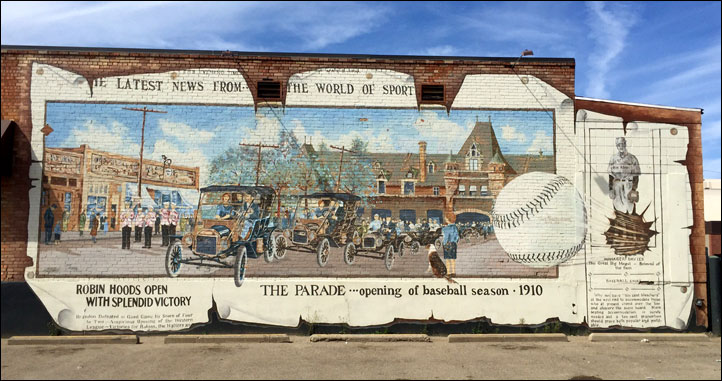
The mural, one of nearly 50 in Moose Jaw, is at 82 Manitoba St. W., painted by Gus Froese.
19 August, 2016
![]() In the early days of baseball coverage there was no attempt to separate "news" from "opinion". The baseball reporters obviously felt no hesitation in offering their own takes on the games.
In the early days of baseball coverage there was no attempt to separate "news" from "opinion". The baseball reporters obviously felt no hesitation in offering their own takes on the games.
This note from the July 25th edition of the 1901 Vancouver Daily Word :
... the Vancouver team ... gave a most woeful exhibition of baseball, and the visitors simply played rag with them ... Hundreds left the grand stand before the game had finished disgusted with the kindergarten work of the locals.
Over in Manitoba, it was much the same (with references that wouldn't get past editors these days) : :
The French-Canadians had on their batting clothes in the first innings and pounded Cousley all over, scoring three runs. Cousley, however, had not got his arm in shape before he went in the box, but in the next innings, he shut his men out 1, 2, 3. The third, however, was a hard one for Cousley, as the St. Boniface aggregation scored 4 runs. It was not Cousley fault however, for his team made errors enough to loose any game. Rowden on first base was unable to hold anything, while Kean at third was only taking up space. Richards, who played first at left field and then at right, was certainly an apology for a ball player and the uniform must have felt dreadfully out of place. He picked the ball up in very much the same way that an old woman would lift a hot stove. [Winnipeg Tribune, August 22, 1901]
The writers tried their best as wordsmiths :
The Vancouver baseball nine kept up its record by winning from Seattle, in one of the poorest exhibitions of baseball ever seen in this city ... Two thousand people turned out to see the Seattle baseball team play Vancouver on the Powell Street grounds on Saturday afternoon. The crowd was so great that many in the grand stand were compelled to stand during the entire match. It was a thoroughly representative gathering. There were ministers of the gospel, doctors, lawyers, members of parliament, maidens of 16 summers, old maids, small boys and girls and infants in arms. The excitement as the game proceeded was intense, in fact at times the enthusiasm of the crowd knew no bounds. The people stood up in the grand stand, waved hats, and cheered like mad. The ladies were equally as interested as the men, the fair sex being represented by about 400. (Vancouver Daily World, 17 June, 1901)
These excerpts come from the game reports that are now posted in the 1900 and 1901 sections. The Manitoba and BC sections are the more expansive but there are significant additions to the District of Alberta and Assiniboia pages as well (remember, the provinces of Alberta and Saskatchewan did not exist until 1905).
1900 - Manitoba, Assiniboia & Saskatchewan, Alberta, British Columbia, Rosters
1901 - Manitoba, Assiniboia & Saskatchewan, Alberta, British Columbia, Rosters, Manitoba Photo Gallery
![]() Missing links? Or, more specifically, missing pages? Over the next few weeks there are likely to be a few of those as I re-organize to prepare to deal with a huge stack of back-logged material. Some links will be in place before the actual material has been posted. Seems it's easier to me to update and add if the links are already there.
Missing links? Or, more specifically, missing pages? Over the next few weeks there are likely to be a few of those as I re-organize to prepare to deal with a huge stack of back-logged material. Some links will be in place before the actual material has been posted. Seems it's easier to me to update and add if the links are already there.
![]() Just to ensure our ace correspondents Rich Necker and Henry Ropertz are never far from a mystery, we offer the following photograph. What we know is that is from 1932, taken at Steveston BC, showing baseball players on a wooden platform at the back of a truck. The players uniforms have BC Pulp on the front along with a crest which has the letters WF. This is from the Nikkei National Museum in Burnaby and is among the photos they would love to identify. This is tied in with some photos of the Steveston team from 1934 and two other unknown seasons for which we seek player IDs and further information.
Just to ensure our ace correspondents Rich Necker and Henry Ropertz are never far from a mystery, we offer the following photograph. What we know is that is from 1932, taken at Steveston BC, showing baseball players on a wooden platform at the back of a truck. The players uniforms have BC Pulp on the front along with a crest which has the letters WF. This is from the Nikkei National Museum in Burnaby and is among the photos they would love to identify. This is tied in with some photos of the Steveston team from 1934 and two other unknown seasons for which we seek player IDs and further information.

17 August, 2016
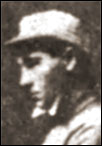
![]() Tangent number two (see Bob Brown below as No. 1) was an effort to determine the first name of Nicholls (as it was generally spelled), Vancouver's ace hurler of 1902. The right-hander won at least 17 games and probably two more where he was scheduled to pitch but for which we've unable so far to find game details. Thus, more than likely he had a 19-7 record. Not bad for a pitcher who didn't join the team until June 21st. A highlight was Nichols' near-perfect game as he allowed just a walk in a no-hitter against Nanaimo.
Tangent number two (see Bob Brown below as No. 1) was an effort to determine the first name of Nicholls (as it was generally spelled), Vancouver's ace hurler of 1902. The right-hander won at least 17 games and probably two more where he was scheduled to pitch but for which we've unable so far to find game details. Thus, more than likely he had a 19-7 record. Not bad for a pitcher who didn't join the team until June 21st. A highlight was Nichols' near-perfect game as he allowed just a walk in a no-hitter against Nanaimo.
The lone early clue was that he had been recruited from the playing fields of San Francisco. After many false leads, it turns out it was Ernest Nichols, just 19 years old when he began play with the Vancouver nine.
However, his promising career was cut short. A year later, after a spectacular beginning in professional ball with Spokane, 20 wins in his first 24 decisions, he was dead, victim of an apparent heart attack. A story on the front page of the sports section of the San Francisco paper made the connection between the young California hurler and his time in Vancouver.


![]() Both the Brown and Nicholls stories followed the 1902 BC game reports fed in by our Rich Necker. We also have game reports for Manitoba and Assiniboia. The roster page reflects all the new game stories and box scores encountered.
Both the Brown and Nicholls stories followed the 1902 BC game reports fed in by our Rich Necker. We also have game reports for Manitoba and Assiniboia. The roster page reflects all the new game stories and box scores encountered.
Even we were surprised in finding a few BC player photos as well as a couple of snapshots. Among the individual photos are those of the ace hurlers of the University of California, Berkeley (it might have been the only U of C campus at the time), Orval Overal (left) and Richard Williams (right).
Also from the 1902 reports we've discovered three more major leaguers - Ike Rockenfield, Jerry Freeman and Charlie Ziegler.
09 August, 2016
![]() Sometimes those research tangents can result in the most unexpected findings.
Sometimes those research tangents can result in the most unexpected findings.
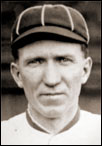 In 1902, one of the American teams to play in Vancouver was a group from Pendleton, Oregon. In an attempt to determine if the playing manager of the team was Zaggler, Zeigler or Ziegler, I discovered not only that it was Charles W. Ziegler, a former major leaguer but found the first name of Pendleton's backup catcher, named Brown. The first name was Bob. Now, it was a long shot, but could this Bob Brown be the one who became such a favourite in Vancouver as a player, manager, promoter, owner, and builder that he became Mr. Baseball in the city?
In 1902, one of the American teams to play in Vancouver was a group from Pendleton, Oregon. In an attempt to determine if the playing manager of the team was Zaggler, Zeigler or Ziegler, I discovered not only that it was Charles W. Ziegler, a former major leaguer but found the first name of Pendleton's backup catcher, named Brown. The first name was Bob. Now, it was a long shot, but could this Bob Brown be the one who became such a favourite in Vancouver as a player, manager, promoter, owner, and builder that he became Mr. Baseball in the city?
Yep.
Brown, a veteran player, ended up purchasing the Vancouver team and as the owner/playing manager his Beavers, won pennants in 1911, 1914 and 1922. He was behind the construction of Capilano Stadium and a fixture in Vancouver baseball until his death in 1962.
There may never be a more successful man in Vancouver baseball, for nobody in Vancouver baseball ever won warmer or wilder esteem and nobody relished it more. He entered professional baseball in 1900, when it was a game for roughnecks. He saw it become respectable. He cultivated it in Vancouver for 53 years, cussing and coddling it and bringing it to a hesitant flower. In the last decade he enjoyed his sports-page designation as a Grand Old Man. (Dick Beddoes, Vancouver Sun , June 23, 1962)
Brown was inducted into the Canadian Baseball Hall of Fame in 1989.
![]() It's done ? (See below) Well, not quite. In trying to develop a plan to deal with a huge pile of material sent by Rich Necker and Henry Ropertz I decided to first put together the roster pages and thus, more additions to the roster sheets - about 1,700 additions in all (along with about 500 deletions as duplications were discovered and consolidations done). The new batch of roster sheets have now been posted. They include nearly 47-thousand players.
It's done ? (See below) Well, not quite. In trying to develop a plan to deal with a huge pile of material sent by Rich Necker and Henry Ropertz I decided to first put together the roster pages and thus, more additions to the roster sheets - about 1,700 additions in all (along with about 500 deletions as duplications were discovered and consolidations done). The new batch of roster sheets have now been posted. They include nearly 47-thousand players.
Through the amazing research of Mr. Necker, now included are players from teams in the early years of baseball on the prairies and BC covering the years of 1900, 1901, 1902, 1903, 1904, 1905 and 1906. There are also players from Brandon local teams from 1904 through to 1912, 1926 and 1931. On the roster pages of 1918, 1919, 1920, 1922, 1927 and 1928 the focus is on players in Winnipeg leagues.
The 1954 rosters now include all the BC players for that season from the Vancouver & Lower Mainland teams, Victoria and Island teams and the BC Interior.
20 July, 2016
![]() Whew. It's done !
Whew. It's done !
The two major lists of players have been consolidated (a separate list of players in British Columbia has been combined with our basic list which has been the main focus since we began the exercise more than 15 years ago). The Basin League (South Dakota-Nebraska) list remains a separate entity.
The first task, however, was a huge update of hundreds of new entries, mainly from BC and Manitoba. In total, we now have 45,389 different players listed. Duplication of player entries remains a concern, but with so many identified during their playing days only by last name or having various spellings of their names, it likely will remain a challenge for years to come.
Among the benefits of the updates is the discovery of another pair of major leaguers, Ike Rockenfield and Jerry Freeman who suited up with Vancouver teams back in 1902 !
The lists, divided into decades, are available on the Players Page. There is a separate page with the codes for all the teams.
